Mary Cronk Farrell's Blog
February 28, 2025
Wash, Rinse, Re—Stop! Here's How You Bring the Status Quo to a Standstill
The washerwomen in Atlanta, Georgia, were so low on the ladder, they hung on the bottom rung by a clothespin. They knew they deserved to climb higher.
In the summer of 1881, a few of them threw out the wash-water, leveraged the little clout they had, and brought the powers-that-be in the City of Atlanta to their knees, or more accurately, their dirty drawers.
 Woman African American woman washing laundry outdoors in a yard in or near Richmond County, Ga., in late 19th century. Only 15-20 years before, these Black women were enslaved by the very people who now employed them to do their wash. Though a constitutional amendment guaranteed their freedom, the white families in Atlanta still had the Black women trapped.
Woman African American woman washing laundry outdoors in a yard in or near Richmond County, Ga., in late 19th century. Only 15-20 years before, these Black women were enslaved by the very people who now employed them to do their wash. Though a constitutional amendment guaranteed their freedom, the white families in Atlanta still had the Black women trapped.
Until the washerwomen exercised their most powerful weapon: unity.
They wrote the mayor, "We mean business...or no washing."
Let me paint a picture of Atlanta in 1881. Destroyed by General Sherman at the end of the Civil War, the city was rising from the ashes. In fact they called it the Phoenix City of the South.
In truth is was struggling to rise above the sewage. The only water system served wealthy white neighborhoods in the Central District, where big houses sat back from the dirty streets.
City boosters advertised Atlanta's plentiful, subservient workforce in an effort to entice northern businesses. New industry arrived, including slaughter houses and stock pens of pigs.
But leaders failed to extend water and sewage lines for most residents. Atlanta’s poor and working class families lived in row houses, tenements, and shanties on the outskirt low lands. Everything ran down hill.
The neighborhoods suffered seasonal flooding and poor drainage. Outdoor privies contaminated wells and springs. Dead animals rotted in the street where they fell. And the better-off townsfolk dumped their household garbage in the poor neighborhoods.
In short, the whole city stank. Here's one of the better streets in the outskirts of town.
 Black neighborhood in Atlanta, Georgia. Library of Congress photo. It was up to the washerwomen to keep at least the clothes clean. Ninety-eight percent of Atlanta’s Black women worked as domestics for former slave owners, the largest number washing laundry. They started work as young as ten, and could not count on retirement.
Black neighborhood in Atlanta, Georgia. Library of Congress photo. It was up to the washerwomen to keep at least the clothes clean. Ninety-eight percent of Atlanta’s Black women worked as domestics for former slave owners, the largest number washing laundry. They started work as young as ten, and could not count on retirement.
Black women earned low wages for long hours cooking, cleaning and caring for kids, all the time under the oppressive eye of their employers. Laundresses had a bit more freedom, working at their own homes or neighborhoods and on their own schedules, as much as one can schedule work that goes on all day every day.
A typical washerwoman started Monday, picking up dirty bundles from the homes of white families and cleaning them during the week to return before Sunday. Hiring a washerwoman was affordable even for working class whites.
It was hard labor, customers were demanding and if they shorted the pay, a woman had no recourse. Woman washing clothes with children’s help circa 1900. Library of Congress. Large cotton mills in the north made cloth readily available and much cheaper than ever. People had more clothes and changed them more often. Each family had mounds of laundry: dresses, shirts and pants, plus tablecloths, napkins, dirty sheets, underwear and diapers.
Woman washing clothes with children’s help circa 1900. Library of Congress. Large cotton mills in the north made cloth readily available and much cheaper than ever. People had more clothes and changed them more often. Each family had mounds of laundry: dresses, shirts and pants, plus tablecloths, napkins, dirty sheets, underwear and diapers.
First water had to be carried from the pump and heated in an iron pot over a fire.Then it was poured in a tub where the washerwoman rubbed the clothes on the washboard with soap, rinsed them and ran everything through a ringer the children cranked by hand. Next, all the laundry was hung on the line to dry.
Someone had to keep hauling water from the pump to keep the pot on the fire full and boiling. The women provided their own soap, making it at home from lye and starch from wheat bran. And when the clothes were dry, the woman heated irons in the coals and ironed them, taking care to press collars and pleats.
"I could clean my hearth good and nice and set my irons in front of the fire and iron all day [with]out stopping....I cooked and ironed at the same time," said laundress Sarah Hill.
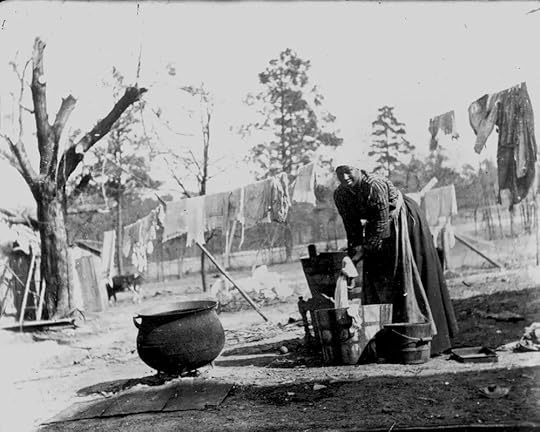 Woman African American woman washing laundry outdoors in a yard in or near Richmond County, Ga., in late 19th century, Robert E. Williams Photographic Collection, Hargrett Rare Book and Manuscript Library, University of Georgia Libraries. handful of Atlanta washerwomen got together in July, 1881, and formed a trade union. They called themselves The Washing Society.
Woman African American woman washing laundry outdoors in a yard in or near Richmond County, Ga., in late 19th century, Robert E. Williams Photographic Collection, Hargrett Rare Book and Manuscript Library, University of Georgia Libraries. handful of Atlanta washerwomen got together in July, 1881, and formed a trade union. They called themselves The Washing Society.
The women needed higher pay. Working their fingers raw and their backs bent, they could hardly feed their families. They also wanted more autonomy and respect.
The Washing Society decided to demand a uniform rate of one dollar for every dozen pounds of wash. They went door-to-door recruiting members on all sides of town. Black ministers helped spread the word and the trade union called a mass meeting to organize a strike.
A few white customers agreed to meet the society's demands. Others sent their laundry out of town.
The newspaper declare the laundresses were demanding “unreasonably high prices.” However, within three weeks, membership in the society grew from 20 to 3000, and dirty clothes piled up in homes throughout the city.
The women rallied nightly for speeches and prayer meetings, bolstering each other's persistence.
"[A] "thoroughly organized association...." the Atlanta Constitution wrote: “The Washerwomen's strike is assuming vast proportions and despite the apparent independence of the white people, is causing quite an inconvenience among our citizens.”
There remains almost no documentation of the strike beyond a few newspaper articles and we only know the names of a few strikers because they were arrested as the city applied pressure to end the strike.
Authorities charged Matilda Crawford, Sallie Bell, Carrie Jones, Dora Jones, Orphelia Turner and Sarah A. Collier with disorderly conduct and quarreling and assessed five dollar fine. Apparently, all but one paid and went free. "In the case of Sarah A. Collier," the newspaper reported, "twenty dollars was assessed, and the money not being paid, the defendant’s name was transcribed to the chain-gang book, where it will remain for forty days."
The Washing Society timed it strike in the months before Atlanta was due to host the International Cotton Exposition, an effort by the city to promote investment.
 Illustration published in Harper’s Weekly, October 1881. With such a fancy affair on the horizon, city official couldn't have citizens walking around in dirty clothes. They threatened the strikers, floating the possibility of charging members of The Washing Society an annual license fee of $25. In addition, officials tried to eliminate their jobs entirely by offering tax incentives to businessmen to start up steam laundries.
Illustration published in Harper’s Weekly, October 1881. With such a fancy affair on the horizon, city official couldn't have citizens walking around in dirty clothes. They threatened the strikers, floating the possibility of charging members of The Washing Society an annual license fee of $25. In addition, officials tried to eliminate their jobs entirely by offering tax incentives to businessmen to start up steam laundries.
The license would be an enormous expense given the women were lucky to earn eight dollars a month, but they agreed it was worth it for a uniform rate of pay.
The women wrote the city mayor directly: "We the members of our society, are determined to stand to our pledge and make extra charges for washing...and are willing to pay $25 or $50 for licenses as a protection...and will do it before we will be defeated, and then we will have full control of the city’s washing at our own prices."
The letter ended with a promise. "We mean business this week or no washing."
Through united, grassroots organization, Atlanta washerwomen proved themselves a force to be reckoned with. They improved their situation and their income and the strike motivated other black domestic workers, cooks, house servants, nurses and hotel maids to likewise push for wage increases.
Do you want to topple the ladder? Unity and persistence may be the only weapon we have.
In the summer of 1881, a few of them threw out the wash-water, leveraged the little clout they had, and brought the powers-that-be in the City of Atlanta to their knees, or more accurately, their dirty drawers.
 Woman African American woman washing laundry outdoors in a yard in or near Richmond County, Ga., in late 19th century. Only 15-20 years before, these Black women were enslaved by the very people who now employed them to do their wash. Though a constitutional amendment guaranteed their freedom, the white families in Atlanta still had the Black women trapped.
Woman African American woman washing laundry outdoors in a yard in or near Richmond County, Ga., in late 19th century. Only 15-20 years before, these Black women were enslaved by the very people who now employed them to do their wash. Though a constitutional amendment guaranteed their freedom, the white families in Atlanta still had the Black women trapped.Until the washerwomen exercised their most powerful weapon: unity.
They wrote the mayor, "We mean business...or no washing."
Let me paint a picture of Atlanta in 1881. Destroyed by General Sherman at the end of the Civil War, the city was rising from the ashes. In fact they called it the Phoenix City of the South.
In truth is was struggling to rise above the sewage. The only water system served wealthy white neighborhoods in the Central District, where big houses sat back from the dirty streets.
City boosters advertised Atlanta's plentiful, subservient workforce in an effort to entice northern businesses. New industry arrived, including slaughter houses and stock pens of pigs.
But leaders failed to extend water and sewage lines for most residents. Atlanta’s poor and working class families lived in row houses, tenements, and shanties on the outskirt low lands. Everything ran down hill.
The neighborhoods suffered seasonal flooding and poor drainage. Outdoor privies contaminated wells and springs. Dead animals rotted in the street where they fell. And the better-off townsfolk dumped their household garbage in the poor neighborhoods.
In short, the whole city stank. Here's one of the better streets in the outskirts of town.
 Black neighborhood in Atlanta, Georgia. Library of Congress photo. It was up to the washerwomen to keep at least the clothes clean. Ninety-eight percent of Atlanta’s Black women worked as domestics for former slave owners, the largest number washing laundry. They started work as young as ten, and could not count on retirement.
Black neighborhood in Atlanta, Georgia. Library of Congress photo. It was up to the washerwomen to keep at least the clothes clean. Ninety-eight percent of Atlanta’s Black women worked as domestics for former slave owners, the largest number washing laundry. They started work as young as ten, and could not count on retirement.Black women earned low wages for long hours cooking, cleaning and caring for kids, all the time under the oppressive eye of their employers. Laundresses had a bit more freedom, working at their own homes or neighborhoods and on their own schedules, as much as one can schedule work that goes on all day every day.
A typical washerwoman started Monday, picking up dirty bundles from the homes of white families and cleaning them during the week to return before Sunday. Hiring a washerwoman was affordable even for working class whites.
It was hard labor, customers were demanding and if they shorted the pay, a woman had no recourse.
 Woman washing clothes with children’s help circa 1900. Library of Congress. Large cotton mills in the north made cloth readily available and much cheaper than ever. People had more clothes and changed them more often. Each family had mounds of laundry: dresses, shirts and pants, plus tablecloths, napkins, dirty sheets, underwear and diapers.
Woman washing clothes with children’s help circa 1900. Library of Congress. Large cotton mills in the north made cloth readily available and much cheaper than ever. People had more clothes and changed them more often. Each family had mounds of laundry: dresses, shirts and pants, plus tablecloths, napkins, dirty sheets, underwear and diapers.First water had to be carried from the pump and heated in an iron pot over a fire.Then it was poured in a tub where the washerwoman rubbed the clothes on the washboard with soap, rinsed them and ran everything through a ringer the children cranked by hand. Next, all the laundry was hung on the line to dry.
Someone had to keep hauling water from the pump to keep the pot on the fire full and boiling. The women provided their own soap, making it at home from lye and starch from wheat bran. And when the clothes were dry, the woman heated irons in the coals and ironed them, taking care to press collars and pleats.
"I could clean my hearth good and nice and set my irons in front of the fire and iron all day [with]out stopping....I cooked and ironed at the same time," said laundress Sarah Hill.
 Woman African American woman washing laundry outdoors in a yard in or near Richmond County, Ga., in late 19th century, Robert E. Williams Photographic Collection, Hargrett Rare Book and Manuscript Library, University of Georgia Libraries. handful of Atlanta washerwomen got together in July, 1881, and formed a trade union. They called themselves The Washing Society.
Woman African American woman washing laundry outdoors in a yard in or near Richmond County, Ga., in late 19th century, Robert E. Williams Photographic Collection, Hargrett Rare Book and Manuscript Library, University of Georgia Libraries. handful of Atlanta washerwomen got together in July, 1881, and formed a trade union. They called themselves The Washing Society.The women needed higher pay. Working their fingers raw and their backs bent, they could hardly feed their families. They also wanted more autonomy and respect.
The Washing Society decided to demand a uniform rate of one dollar for every dozen pounds of wash. They went door-to-door recruiting members on all sides of town. Black ministers helped spread the word and the trade union called a mass meeting to organize a strike.
A few white customers agreed to meet the society's demands. Others sent their laundry out of town.
The newspaper declare the laundresses were demanding “unreasonably high prices.” However, within three weeks, membership in the society grew from 20 to 3000, and dirty clothes piled up in homes throughout the city.
The women rallied nightly for speeches and prayer meetings, bolstering each other's persistence.
"[A] "thoroughly organized association...." the Atlanta Constitution wrote: “The Washerwomen's strike is assuming vast proportions and despite the apparent independence of the white people, is causing quite an inconvenience among our citizens.”
There remains almost no documentation of the strike beyond a few newspaper articles and we only know the names of a few strikers because they were arrested as the city applied pressure to end the strike.
Authorities charged Matilda Crawford, Sallie Bell, Carrie Jones, Dora Jones, Orphelia Turner and Sarah A. Collier with disorderly conduct and quarreling and assessed five dollar fine. Apparently, all but one paid and went free. "In the case of Sarah A. Collier," the newspaper reported, "twenty dollars was assessed, and the money not being paid, the defendant’s name was transcribed to the chain-gang book, where it will remain for forty days."
The Washing Society timed it strike in the months before Atlanta was due to host the International Cotton Exposition, an effort by the city to promote investment.
 Illustration published in Harper’s Weekly, October 1881. With such a fancy affair on the horizon, city official couldn't have citizens walking around in dirty clothes. They threatened the strikers, floating the possibility of charging members of The Washing Society an annual license fee of $25. In addition, officials tried to eliminate their jobs entirely by offering tax incentives to businessmen to start up steam laundries.
Illustration published in Harper’s Weekly, October 1881. With such a fancy affair on the horizon, city official couldn't have citizens walking around in dirty clothes. They threatened the strikers, floating the possibility of charging members of The Washing Society an annual license fee of $25. In addition, officials tried to eliminate their jobs entirely by offering tax incentives to businessmen to start up steam laundries. The license would be an enormous expense given the women were lucky to earn eight dollars a month, but they agreed it was worth it for a uniform rate of pay.
The women wrote the city mayor directly: "We the members of our society, are determined to stand to our pledge and make extra charges for washing...and are willing to pay $25 or $50 for licenses as a protection...and will do it before we will be defeated, and then we will have full control of the city’s washing at our own prices."
The letter ended with a promise. "We mean business this week or no washing."
Through united, grassroots organization, Atlanta washerwomen proved themselves a force to be reckoned with. They improved their situation and their income and the strike motivated other black domestic workers, cooks, house servants, nurses and hotel maids to likewise push for wage increases.
Do you want to topple the ladder? Unity and persistence may be the only weapon we have.
Published on February 28, 2025 11:09
August 19, 2024
When a Female Spy Breaks the Glass Ceiling, Does Anyone Hear It Shatter?
Don't be surprised if you haven't heard of Elizabeth Sudmeier, a spy craft pioneer who crashed through the glass ceiling of the American Central Intelligence Agency.
Her CIA case files remained classified until just ten years ago, which means we also did not know about the odds she faced, the battles she fought and the determination it took for a woman to succeed in one of the manliest professions in the world.
Like many women in the 1940s and 50s, Elizabeth began her career as a typist, but she went on to become the first woman American CIA secret agent.
During the Cold War, on assignment in the Middle East, Elizabeth procured volumes of details about Soviet Military hardware that turned out to be invaluable to US defense.
Women CIA agents were offered little respect in the 1950s, as I told you in this story First Active Duty CIA Officer to Die was a Woman. And They Lied About It . Still, Elizabeth Sudmeier performed her assignments with dedication and excellence becoming the first CIA woman to recruit and handle foreign assets.
One side note, an unnamed woman of the Sioux Nation no doubt contributed to Elisabeth's success, as her nanny, she practically raised the girl throughout her early years. Elizabeth Sudmeier prior to her service in the CIA. Picture an American woman melting into the scene outside a cafe in Baghdad, waiting for a clandestine meeting. She's spent the last six months persuading a particular man to work with her. The stakes are high for America and for the both of them. If they're caught, they will likely pay with their lives.
Elizabeth Sudmeier prior to her service in the CIA. Picture an American woman melting into the scene outside a cafe in Baghdad, waiting for a clandestine meeting. She's spent the last six months persuading a particular man to work with her. The stakes are high for America and for the both of them. If they're caught, they will likely pay with their lives.
The year is 1954 and the US and USSR maintain a tense standoff with arsenals of nuclear and conventional weapons. When the man shows up, it's only for a moment, long enough to hand this female spy an envelope. She has just stolen Soviet secrets.
Elizabeth holds blueprints for the Soviet MiG-19 jet fighter.
Over time, through this source, Elizabeth also gained details of the MiG-21 fighter, the SA2 missile, and dozens of volumes of technical manuals relating to Soviet military systems and equipment. This type of information proved extremely valuable to the US in understanding the capabilities of Soviet weapons.
Elizabeth set up seemingly accidental encounters with her source at coffee houses, cafes or a movie theater. As they met briefly, he handed off materials that she carried to a secure location for copying. Then Elizabeth returned the documents to the informant later that night.
When Elizabeth went to work in the Middle East, CIA officials didn't plan on female agents courting relationships with foreign assets and managing them. Named a "Reports Officer," she was expected to stay in her lane and do tamer work.
According to one CIA review in 1960 “there is a general feeling that the preparation of reports is a tedious and incidental chore, to be avoided like the plague by any promising and ambitious young man who wants to get ahead in operations.”
But she proved herself, and thus other women, could successfully run operations under the intense pressure in the world of counterintelligence. She also did so under the aggressive scrutiny of her male bosses.
After her work in Baghdad securing important Soviet secrets, Elizabeth's station chief nominated her for the Intelligence Medal of Merit, which prompted controversy over whether a female who was not listed as an operations officer could win distinction for an operational act. Colleagues argued on her behalf and eventually in 1962, Elizabeth received the medal.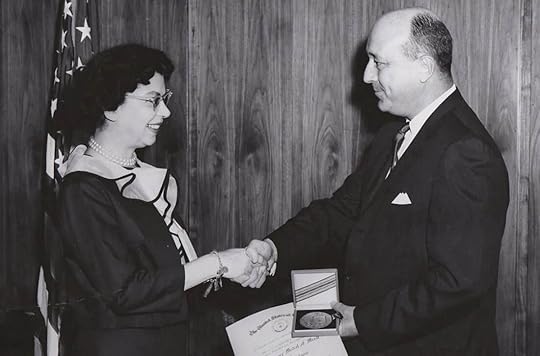 Elizabeth Sudmeier receiving her second medal of honor from the CIA. A CIA officer who knew Elizabeth in the 1950s recalled how she paved the way for women in the CIA: “She was a real pistol…. The fact that she accomplished so much is incredible given the general antagonism of NE officers to women functioning as ops officers."
Elizabeth Sudmeier receiving her second medal of honor from the CIA. A CIA officer who knew Elizabeth in the 1950s recalled how she paved the way for women in the CIA: “She was a real pistol…. The fact that she accomplished so much is incredible given the general antagonism of NE officers to women functioning as ops officers."
Despite of her accomplishments, superiors in the CIA did not promote Elizabeth, passing over her for eight years. An officer who knew her said, "I can tell you outright that hers was a monumental struggle as NE Division was dead set against the idea and concept of a female ops officer.” This was after she had accomplished the job!
Elizabeth was born in 1912, in the small railroad town of Timber Lake, South Dakota, near the Sioux Nation. She was raised by a Sioux nanny for much of her childhood and became fluent in the Sioux language, which her father also spoke.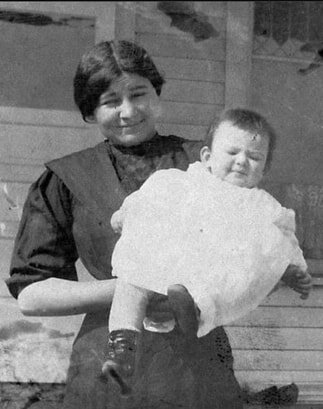 Elizabeth in the arms of her Sioux nanny, 1912. After high school, Elizabeth studied English Literature at The College of St. Catherine in St. Paul, Minnesota, earning a B.A. in 1933.
Elizabeth in the arms of her Sioux nanny, 1912. After high school, Elizabeth studied English Literature at The College of St. Catherine in St. Paul, Minnesota, earning a B.A. in 1933.
She returned to South Dakota and taught high school English a few years, then got a secretarial job at St. Paul, MN bank. During World War II she joined the US Army Women’s Army Auxiliary Corps, where she was assigned to recruiting.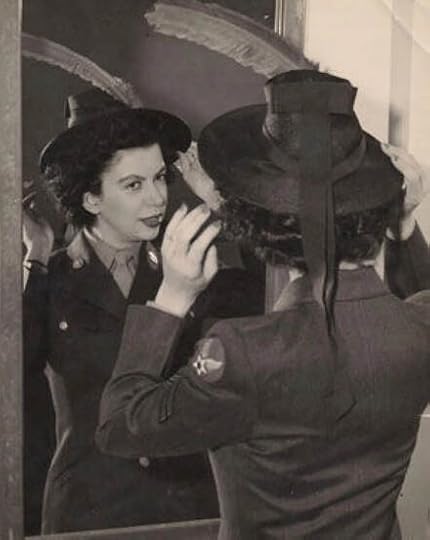 Elizabeth Sudmeier in a Women’s Army Corps recruiting advertisement, 1944. In March 1947, Elizabeth joined the CIA’s predecessor, the Central Intelligence Group (CIG), as a shorthand stenographer in the Office of Reports and Estimates. When the CIA replaced the CIG four months later, Elizabeth became one of the Agency’s charter members
Elizabeth Sudmeier in a Women’s Army Corps recruiting advertisement, 1944. In March 1947, Elizabeth joined the CIA’s predecessor, the Central Intelligence Group (CIG), as a shorthand stenographer in the Office of Reports and Estimates. When the CIA replaced the CIG four months later, Elizabeth became one of the Agency’s charter members
In October 1951 she transferred to the clandestine service, serving in the Middle East and South Asia for almost nine years. Elizabeth took mandatory retirement on May 12, 1972, at age sixty, dying 1989 at 76. Not even her family knew her covert duties and files relating to her work remained classified until February 2014.
However, in 2013, nearly 25 years after he death, Elizabeth received the CIA Trailblazer Award given to “CIA officers whose leadership, achievements, and dedication to mission had a significant impact on the agency’s history and legacy.”
Sources
https://www.wsj.com/articles/the-women-who-helped-to-build-the-cia-11663992062
https://x.com/CIA/status/1113554329833758720
https://www.stkate.edu/newswire/news/elizabeth-sudmeier-cia-trailblazer
https://www.elespanol.com/social/20190408/verdadera-viuda-negra-cia-rescata-fundadora-olvidada/388711686_0.html
https://web.archive.org/web/20150905093741/https://www.cia.gov/news-information/featured-story-archive/2015-featured-story-archive/elizabeth-sudmeier-story.html
Her CIA case files remained classified until just ten years ago, which means we also did not know about the odds she faced, the battles she fought and the determination it took for a woman to succeed in one of the manliest professions in the world.
Like many women in the 1940s and 50s, Elizabeth began her career as a typist, but she went on to become the first woman American CIA secret agent.
During the Cold War, on assignment in the Middle East, Elizabeth procured volumes of details about Soviet Military hardware that turned out to be invaluable to US defense.
Women CIA agents were offered little respect in the 1950s, as I told you in this story First Active Duty CIA Officer to Die was a Woman. And They Lied About It . Still, Elizabeth Sudmeier performed her assignments with dedication and excellence becoming the first CIA woman to recruit and handle foreign assets.
One side note, an unnamed woman of the Sioux Nation no doubt contributed to Elisabeth's success, as her nanny, she practically raised the girl throughout her early years.
 Elizabeth Sudmeier prior to her service in the CIA. Picture an American woman melting into the scene outside a cafe in Baghdad, waiting for a clandestine meeting. She's spent the last six months persuading a particular man to work with her. The stakes are high for America and for the both of them. If they're caught, they will likely pay with their lives.
Elizabeth Sudmeier prior to her service in the CIA. Picture an American woman melting into the scene outside a cafe in Baghdad, waiting for a clandestine meeting. She's spent the last six months persuading a particular man to work with her. The stakes are high for America and for the both of them. If they're caught, they will likely pay with their lives.The year is 1954 and the US and USSR maintain a tense standoff with arsenals of nuclear and conventional weapons. When the man shows up, it's only for a moment, long enough to hand this female spy an envelope. She has just stolen Soviet secrets.
Elizabeth holds blueprints for the Soviet MiG-19 jet fighter.
Over time, through this source, Elizabeth also gained details of the MiG-21 fighter, the SA2 missile, and dozens of volumes of technical manuals relating to Soviet military systems and equipment. This type of information proved extremely valuable to the US in understanding the capabilities of Soviet weapons.
Elizabeth set up seemingly accidental encounters with her source at coffee houses, cafes or a movie theater. As they met briefly, he handed off materials that she carried to a secure location for copying. Then Elizabeth returned the documents to the informant later that night.
When Elizabeth went to work in the Middle East, CIA officials didn't plan on female agents courting relationships with foreign assets and managing them. Named a "Reports Officer," she was expected to stay in her lane and do tamer work.
According to one CIA review in 1960 “there is a general feeling that the preparation of reports is a tedious and incidental chore, to be avoided like the plague by any promising and ambitious young man who wants to get ahead in operations.”
But she proved herself, and thus other women, could successfully run operations under the intense pressure in the world of counterintelligence. She also did so under the aggressive scrutiny of her male bosses.
After her work in Baghdad securing important Soviet secrets, Elizabeth's station chief nominated her for the Intelligence Medal of Merit, which prompted controversy over whether a female who was not listed as an operations officer could win distinction for an operational act. Colleagues argued on her behalf and eventually in 1962, Elizabeth received the medal.
 Elizabeth Sudmeier receiving her second medal of honor from the CIA. A CIA officer who knew Elizabeth in the 1950s recalled how she paved the way for women in the CIA: “She was a real pistol…. The fact that she accomplished so much is incredible given the general antagonism of NE officers to women functioning as ops officers."
Elizabeth Sudmeier receiving her second medal of honor from the CIA. A CIA officer who knew Elizabeth in the 1950s recalled how she paved the way for women in the CIA: “She was a real pistol…. The fact that she accomplished so much is incredible given the general antagonism of NE officers to women functioning as ops officers."Despite of her accomplishments, superiors in the CIA did not promote Elizabeth, passing over her for eight years. An officer who knew her said, "I can tell you outright that hers was a monumental struggle as NE Division was dead set against the idea and concept of a female ops officer.” This was after she had accomplished the job!
Elizabeth was born in 1912, in the small railroad town of Timber Lake, South Dakota, near the Sioux Nation. She was raised by a Sioux nanny for much of her childhood and became fluent in the Sioux language, which her father also spoke.
 Elizabeth in the arms of her Sioux nanny, 1912. After high school, Elizabeth studied English Literature at The College of St. Catherine in St. Paul, Minnesota, earning a B.A. in 1933.
Elizabeth in the arms of her Sioux nanny, 1912. After high school, Elizabeth studied English Literature at The College of St. Catherine in St. Paul, Minnesota, earning a B.A. in 1933.She returned to South Dakota and taught high school English a few years, then got a secretarial job at St. Paul, MN bank. During World War II she joined the US Army Women’s Army Auxiliary Corps, where she was assigned to recruiting.
 Elizabeth Sudmeier in a Women’s Army Corps recruiting advertisement, 1944. In March 1947, Elizabeth joined the CIA’s predecessor, the Central Intelligence Group (CIG), as a shorthand stenographer in the Office of Reports and Estimates. When the CIA replaced the CIG four months later, Elizabeth became one of the Agency’s charter members
Elizabeth Sudmeier in a Women’s Army Corps recruiting advertisement, 1944. In March 1947, Elizabeth joined the CIA’s predecessor, the Central Intelligence Group (CIG), as a shorthand stenographer in the Office of Reports and Estimates. When the CIA replaced the CIG four months later, Elizabeth became one of the Agency’s charter members In October 1951 she transferred to the clandestine service, serving in the Middle East and South Asia for almost nine years. Elizabeth took mandatory retirement on May 12, 1972, at age sixty, dying 1989 at 76. Not even her family knew her covert duties and files relating to her work remained classified until February 2014.
However, in 2013, nearly 25 years after he death, Elizabeth received the CIA Trailblazer Award given to “CIA officers whose leadership, achievements, and dedication to mission had a significant impact on the agency’s history and legacy.”
Sources
https://www.wsj.com/articles/the-women-who-helped-to-build-the-cia-11663992062
https://x.com/CIA/status/1113554329833758720
https://www.stkate.edu/newswire/news/elizabeth-sudmeier-cia-trailblazer
https://www.elespanol.com/social/20190408/verdadera-viuda-negra-cia-rescata-fundadora-olvidada/388711686_0.html
https://web.archive.org/web/20150905093741/https://www.cia.gov/news-information/featured-story-archive/2015-featured-story-archive/elizabeth-sudmeier-story.html
Published on August 19, 2024 13:20
August 3, 2024
Women Who Boycotted Hitler’s Olympics & what we've inherited from 1936
I love the Olympic Games! This year I've only been able to watch a curated selection of events, and the stories of the athletes are amazing as always, their challenges, the competition, the excellence in sport and, of course, the medals. So much to inspire us!
This summer in Paris, as has been true in other host cities in the past, there's a dark side to the sparkling events.
French authorities cleared out homeless encampments for months prior to the opening ceremonies, busing "undesirable people" out of the city center to the fringes of Paris. Authorities have been sharply criticized as thousands of migrants, squatters, sex workers and families down on their luck have ended up with no shelter.
A spokesman for the regional government denied the accusations pre-games "social cleansing" and said the government has relocated migrants from the city for years.
“We are taking care of them. We don’t really understand the criticism because we are very much determined to offer places for these people."
Hear the stories and see photos from Associated Press here .
Or here from ABC News. (5-minute read)
Our modern games owe their grand themes, magnificent Olympic stadiums and even cost-overruns to the precedent set by Adolf Hitler's in 1936. The Berlin games were the first ever broadcast on television, and the first to feature the Olympic torch relay from Greece to the site of the games.
Nazis planned the torch-lighting and other pageantry in an all-out effort to host an Olympics that would out-shine all previous games. Hitler's grandiose plans for Germany world domination included taking over the Olympics forever.
In his desire to show the world the superiority of the Aryan race, he "cleaned-up" Berlin. Police arrested nearly one-thousand Roma and Sinti people, interning them in a camp on the edge of the city near Berlin's sewage fields. The Gypsies were later deported to Auschwitz.
Police arrested nearly one-thousand Roma and Sinti people, interning them in a camp on the edge of the city near Berlin's sewage fields. The Gypsies were later deported to Auschwitz.
Few stood up to Nazi propaganda portraying Germany as a tolerant and hospitable nation. The only country to boycott the 1936 games was the Soviet Union. But three young Jewish girls gave up their dreams to follow their consciences.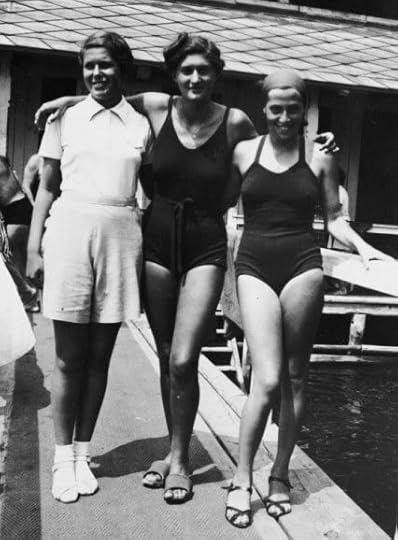 Austrian champion swimmers Judith Deutsch, Ruth Langer and Lucie Goldner, 1936. Judith Deutsch, (left in photo) Austria's top swimmer in the mid-1930s, knew of the persecution of Jews in Germany and she experienced antisemitism in her home country.
Austrian champion swimmers Judith Deutsch, Ruth Langer and Lucie Goldner, 1936. Judith Deutsch, (left in photo) Austria's top swimmer in the mid-1930s, knew of the persecution of Jews in Germany and she experienced antisemitism in her home country.
She and two other Austrian swimmers, Ruth Langer (middle in photo) and Lucie Goldner (right) trained at the Jewish swim club Hakoah in Vienna, Austria because they were barred from public pools, where signs read No entry for dogs and Jews.
Ruth Lager grew up in Vienna and took up swimming at age 11, hoping to excel at something her brother did not. At age 14, she broke the Austrian records for the 100-meter and 400-meter freestyles and won the Austrian championships at those distances.
Judith dominated Austrian swimming 1934-36. She was national champion in the 100-meter freestyle, 200-meter freestyle, and 400-meter freestyle, setting twelve national records in one year. In 1935, she won the country's highest athletic award Outstanding Austrian Athlete.
The three swimmers were selected for the Austrian Olympic Team, due to compete in the 1936 Summer Olympics in Nazi Germany. The games sparked international debate about whether attending the Olympics endorsed Germany's white nationalistic policies and militaristic ambitions.
As the Berlin Olympics approached in 1936, Americans, too, debated whether to attend. The US Olympic Committee President, Avery Bundage traveled to Germany to investigate claims of Nazi discrimination against Jews.
He reported such claims were exaggerated “and the unhindered continuance of the Olympic movement were more important than the German-Jewish situation.”
Lord Melchett of Britain, president of the World Federation of Jewish Sports Clubs recommended Jewish athletes not participate. Not an obvious choice at the time, only a few athletes, Jewish or not, joined the boycott.
Judith, Lucie and Ruth took a stand, saying, ''We do not boycott Olympia, but Berlin."
In an interview with Reuters, Ruth said, "It was a once-in-a-lifetime opportunity. But being Jewish, it was unthinkable to compete in the Games in Nazi Germany, where my people were being persecuted.
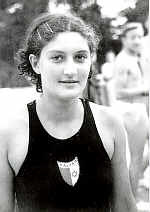 Ruth Langer originally held eight Austrian national swimming records. (United States Holocaust Memorial Museum) Austrian authorities swiftly retaliated, banning the three swimmers from all national and international competition ''due to severe damage of Austrian sports'' and ''gross disrespect for the Olympic spirit.'' In addition, officials erased them from the Austrian record books.
Ruth Langer originally held eight Austrian national swimming records. (United States Holocaust Memorial Museum) Austrian authorities swiftly retaliated, banning the three swimmers from all national and international competition ''due to severe damage of Austrian sports'' and ''gross disrespect for the Olympic spirit.'' In addition, officials erased them from the Austrian record books.
Two years later, Germany annexed Austria and singled out Austrian Jews for even worse discrimination. Viennese athletes forced Ruth to clean the SS and SA barracks.
Still a teenager, Ruth decided to enter a swim meet in Italy. Dying her brown hair blonde, she carried a forged baptismal certificate as proof she was Roman Catholic.
The next year she escaped from Italy to England where, in 1939, she won the British long-distance swimming championship in the Thames.
The other two women also escaped the Holocaust. Lucie Goldner, the Austrian backstroke champion, used her swimming connections to flee to London. After WWII, she eventually moved to Australia, where she continued swimming for another Jewish swim club.
Judith emigrated to Palestine and became the Israeli national champion. She represented Hebrew University at the 1939 World University Games, winning a silver medal.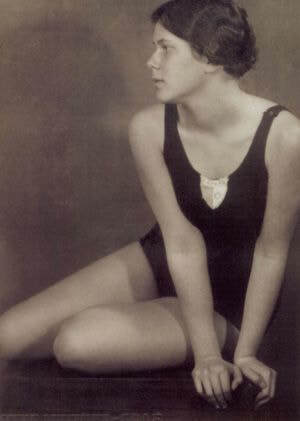 Judith Deutsch Haspel, Israeli national champion swimmer. In 1995, when the Austrian government apologized and reinstated the champions’ records, all three women declined to travel to the ceremony.
Judith Deutsch Haspel, Israeli national champion swimmer. In 1995, when the Austrian government apologized and reinstated the champions’ records, all three women declined to travel to the ceremony.
Judith wrote: "I am happy to accept your apologies and the withdrawal of sanctions against me...And in no way do I regret having done what I did sixty years ago."
Decades later, before the 1996 Atlanta Olympics, Ruth told Reuters: ''Whenever the Games come up again, I get a heartache. It's something that stays with you for the rest of your life.'' Sources
https://www.ushmm.org/exhibition/olympics/?content=jewish_athletes_more
https://collections.ushmm.org/search/catalog/pa1140536
https://apnews.com/article/olympics-2024-paris-migrant-camp-3ef2a08d8da1085148ed409dcb44d6f6
https://abcnews.go.com/Sports/wireStory/migrants-homeless-people-cleared-paris-olympics-112279127
https://www.nytimes.com/1999/06/06/sports/ruth-langer-lawrence-77-who-boycotted-36-olympics.html
https://lilith.org/articles/swimmers-against-the-tide/
https://www.ushmm.org/exhibition/olympics/?content=jewish_athletes_more
https://www.ushmm.org/exhibition/olympics/?content=aftermath&lang=en
This summer in Paris, as has been true in other host cities in the past, there's a dark side to the sparkling events.
French authorities cleared out homeless encampments for months prior to the opening ceremonies, busing "undesirable people" out of the city center to the fringes of Paris. Authorities have been sharply criticized as thousands of migrants, squatters, sex workers and families down on their luck have ended up with no shelter.
A spokesman for the regional government denied the accusations pre-games "social cleansing" and said the government has relocated migrants from the city for years.
“We are taking care of them. We don’t really understand the criticism because we are very much determined to offer places for these people."
Hear the stories and see photos from Associated Press here .
Or here from ABC News. (5-minute read)
Our modern games owe their grand themes, magnificent Olympic stadiums and even cost-overruns to the precedent set by Adolf Hitler's in 1936. The Berlin games were the first ever broadcast on television, and the first to feature the Olympic torch relay from Greece to the site of the games.
Nazis planned the torch-lighting and other pageantry in an all-out effort to host an Olympics that would out-shine all previous games. Hitler's grandiose plans for Germany world domination included taking over the Olympics forever.
In his desire to show the world the superiority of the Aryan race, he "cleaned-up" Berlin.
 Police arrested nearly one-thousand Roma and Sinti people, interning them in a camp on the edge of the city near Berlin's sewage fields. The Gypsies were later deported to Auschwitz.
Police arrested nearly one-thousand Roma and Sinti people, interning them in a camp on the edge of the city near Berlin's sewage fields. The Gypsies were later deported to Auschwitz. Few stood up to Nazi propaganda portraying Germany as a tolerant and hospitable nation. The only country to boycott the 1936 games was the Soviet Union. But three young Jewish girls gave up their dreams to follow their consciences.
 Austrian champion swimmers Judith Deutsch, Ruth Langer and Lucie Goldner, 1936. Judith Deutsch, (left in photo) Austria's top swimmer in the mid-1930s, knew of the persecution of Jews in Germany and she experienced antisemitism in her home country.
Austrian champion swimmers Judith Deutsch, Ruth Langer and Lucie Goldner, 1936. Judith Deutsch, (left in photo) Austria's top swimmer in the mid-1930s, knew of the persecution of Jews in Germany and she experienced antisemitism in her home country.She and two other Austrian swimmers, Ruth Langer (middle in photo) and Lucie Goldner (right) trained at the Jewish swim club Hakoah in Vienna, Austria because they were barred from public pools, where signs read No entry for dogs and Jews.
Ruth Lager grew up in Vienna and took up swimming at age 11, hoping to excel at something her brother did not. At age 14, she broke the Austrian records for the 100-meter and 400-meter freestyles and won the Austrian championships at those distances.
Judith dominated Austrian swimming 1934-36. She was national champion in the 100-meter freestyle, 200-meter freestyle, and 400-meter freestyle, setting twelve national records in one year. In 1935, she won the country's highest athletic award Outstanding Austrian Athlete.
The three swimmers were selected for the Austrian Olympic Team, due to compete in the 1936 Summer Olympics in Nazi Germany. The games sparked international debate about whether attending the Olympics endorsed Germany's white nationalistic policies and militaristic ambitions.
As the Berlin Olympics approached in 1936, Americans, too, debated whether to attend. The US Olympic Committee President, Avery Bundage traveled to Germany to investigate claims of Nazi discrimination against Jews.
He reported such claims were exaggerated “and the unhindered continuance of the Olympic movement were more important than the German-Jewish situation.”
Lord Melchett of Britain, president of the World Federation of Jewish Sports Clubs recommended Jewish athletes not participate. Not an obvious choice at the time, only a few athletes, Jewish or not, joined the boycott.
Judith, Lucie and Ruth took a stand, saying, ''We do not boycott Olympia, but Berlin."
In an interview with Reuters, Ruth said, "It was a once-in-a-lifetime opportunity. But being Jewish, it was unthinkable to compete in the Games in Nazi Germany, where my people were being persecuted.
 Ruth Langer originally held eight Austrian national swimming records. (United States Holocaust Memorial Museum) Austrian authorities swiftly retaliated, banning the three swimmers from all national and international competition ''due to severe damage of Austrian sports'' and ''gross disrespect for the Olympic spirit.'' In addition, officials erased them from the Austrian record books.
Ruth Langer originally held eight Austrian national swimming records. (United States Holocaust Memorial Museum) Austrian authorities swiftly retaliated, banning the three swimmers from all national and international competition ''due to severe damage of Austrian sports'' and ''gross disrespect for the Olympic spirit.'' In addition, officials erased them from the Austrian record books.Two years later, Germany annexed Austria and singled out Austrian Jews for even worse discrimination. Viennese athletes forced Ruth to clean the SS and SA barracks.
Still a teenager, Ruth decided to enter a swim meet in Italy. Dying her brown hair blonde, she carried a forged baptismal certificate as proof she was Roman Catholic.
The next year she escaped from Italy to England where, in 1939, she won the British long-distance swimming championship in the Thames.
The other two women also escaped the Holocaust. Lucie Goldner, the Austrian backstroke champion, used her swimming connections to flee to London. After WWII, she eventually moved to Australia, where she continued swimming for another Jewish swim club.
Judith emigrated to Palestine and became the Israeli national champion. She represented Hebrew University at the 1939 World University Games, winning a silver medal.
 Judith Deutsch Haspel, Israeli national champion swimmer. In 1995, when the Austrian government apologized and reinstated the champions’ records, all three women declined to travel to the ceremony.
Judith Deutsch Haspel, Israeli national champion swimmer. In 1995, when the Austrian government apologized and reinstated the champions’ records, all three women declined to travel to the ceremony.Judith wrote: "I am happy to accept your apologies and the withdrawal of sanctions against me...And in no way do I regret having done what I did sixty years ago."
Decades later, before the 1996 Atlanta Olympics, Ruth told Reuters: ''Whenever the Games come up again, I get a heartache. It's something that stays with you for the rest of your life.'' Sources
https://www.ushmm.org/exhibition/olympics/?content=jewish_athletes_more
https://collections.ushmm.org/search/catalog/pa1140536
https://apnews.com/article/olympics-2024-paris-migrant-camp-3ef2a08d8da1085148ed409dcb44d6f6
https://abcnews.go.com/Sports/wireStory/migrants-homeless-people-cleared-paris-olympics-112279127
https://www.nytimes.com/1999/06/06/sports/ruth-langer-lawrence-77-who-boycotted-36-olympics.html
https://lilith.org/articles/swimmers-against-the-tide/
https://www.ushmm.org/exhibition/olympics/?content=jewish_athletes_more
https://www.ushmm.org/exhibition/olympics/?content=aftermath&lang=en
Published on August 03, 2024 15:50
September 23, 2023
Bomb Attack on Woman Environmentalist remains Unsolved after 30 years
Judi Bari made national headlines 30 years ago with her passionate protests against the clearcutting of California's old growth redwoods.
She helped organize Redwood Summer, a three-month-long, non-violent protest against logging in Humboldt County. Then just weeks before the kick-off event, a homemade bomb exploded under the driver's seat of Judi's car.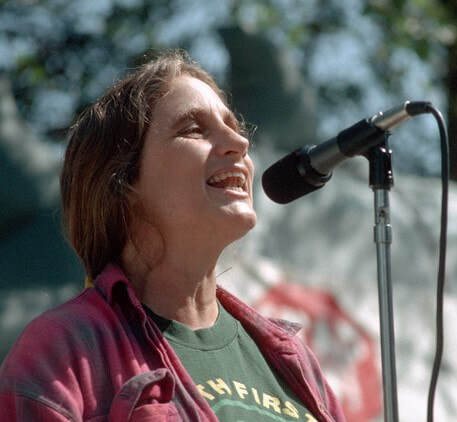 Judi Bari organized nonviolent protests against destructive corporate logging of the redwood forests. Photo courtesy of Greg King Local Oakland, CA, police officers tracked her to the hospital where they arrested the seriously injured woman, labeled her a terrorist and arrested her on arrested on suspicion of transporting illegal explosives. They accused Judi of planting the bomb that nearly killed her.
Judi Bari organized nonviolent protests against destructive corporate logging of the redwood forests. Photo courtesy of Greg King Local Oakland, CA, police officers tracked her to the hospital where they arrested the seriously injured woman, labeled her a terrorist and arrested her on arrested on suspicion of transporting illegal explosives. They accused Judi of planting the bomb that nearly killed her.
Two months later, they dropped the charges due to lack of evidence. But why has no one ever been charged in the crime? The Vietnam War launched Judi Bari's life's work as an activist but her job as a carpenter sparked her "environmental epiphany."
As a student at the University of Maryland, Judi joined protests against the Vietnam War. She moved on to work as a labor organizer in Washington, D.C, leading postal workers to victory in a wildcat strike against the U.S. Postal Service. After her efforts to unionize grocery clerks fizzled, Judi moved to Northern California and took a carpenter job.
While siding a house one day, she marveled at a board she handled. The long piece of wood didn't have a single knot and she wondered aloud if it was old-growth redwood. Her supervisor confirmed the piece of siding had been cut from a redwood 1,000 years old.
''A light bulb went on: We are cutting down old-growth forests to make yuppie houses,'' Judi later told an interviewer. ''I became obsessed with the forests.''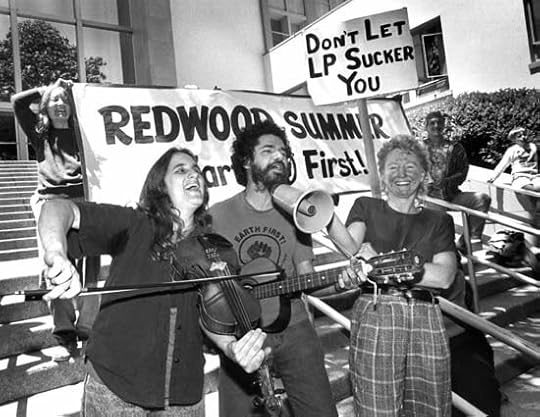 Judi Bari (right), environmentalist, feminist, labor organizer, and musician gearing up for Redwood Summer with colleague Darryl Cherney (center) Darlene (right), 1990. Photo courtesy Evan Johnson. Judi imagined Redwood Summer arousing the civil rights spirit that had characterized protests throughout the South in the summer of 1964 and encouraged student from all over the state to join the protests.
Judi Bari (right), environmentalist, feminist, labor organizer, and musician gearing up for Redwood Summer with colleague Darryl Cherney (center) Darlene (right), 1990. Photo courtesy Evan Johnson. Judi imagined Redwood Summer arousing the civil rights spirit that had characterized protests throughout the South in the summer of 1964 and encouraged student from all over the state to join the protests.
As summer approached, Judi had made little progress convincing lumber workers to help protect the forests and tensions in the community escalated. Judi and other organizers received death threats and a logging truck rammed her car.
On May 24, 1990, she and Darryl Cherney took a concert and speaking tour to recruit college students. They were driving through Oakland when a motion-triggered pipe bomb wrapped with nails exploded directly under Judi's driver's seat.
Judi would be maimed and permanently disabled by her injuries; Darryl suffered minor injuries. The two told paramedics and responding police officers they believed they had been targeted because of their activism against the timber industry. They had copies of the written death threats they're received with them in the car.
 Judi Bari Web Photo Gallery. Judi's bombed car in Oakland Police Department storage, 1990. OPD photo Oakland police, OPD, tracked Judi and Darryl to the hospital, arresting them as primary suspects in the case. Working with the FBI, they pursued a case of terrorism, insisting they had evidence the two activists had been transporting the bomb with evil intent when it accidentally detonated. Originally, the announced to the press that the bomb was in the back seat of the car when it exploded.
Judi Bari Web Photo Gallery. Judi's bombed car in Oakland Police Department storage, 1990. OPD photo Oakland police, OPD, tracked Judi and Darryl to the hospital, arresting them as primary suspects in the case. Working with the FBI, they pursued a case of terrorism, insisting they had evidence the two activists had been transporting the bomb with evil intent when it accidentally detonated. Originally, the announced to the press that the bomb was in the back seat of the car when it exploded.
Arraignment in the case was delayed seven weeks until the District Attorney said he would not file charges due to lack of evidence. The Oakland Police closed the case, but the FBI continued investigating, telling the media Judi and Darryl were their only suspects.
When law enforcement reported no progress in the case a year after the car bombing, Judi and Darryl filed a federal civil rights suit against the FBI and OPD claiming law officers were trying to frame them as terrorists to discredit their political organizing to protect the redwood forests.
The case dragged on for years, but in 2002, a federal jury concluded the pair's civil rights had been violated by the FBI and Oakland Police Department. The two were awarded $4.4 million. Unfortunately, Bari had died of breast cancer in 1997. Her share went to her two teenage daughters.
The jury found that three FBI agents and Three OPD officers had violated the plaintiffs' First Amendment rights to freedom of speech and freedom of assembly, and for the defendants' various unlawful acts, including unlawful search and seizure in violation of the plaintiffs' Fourth Amendment rights.
After the trial's gag order was lifted, a juror told the media that she believed the law enforcement agents had lied.
"Investigators were lying so much it was insulting.... I'm surprised that they seriously expected anyone would believe them ... They were evasive. They were arrogant. They were defensive," said juror Mary Nunn.
As of 2015, North Coast Journal reported it appears no official effort has been made to determine who put that bomb in Bari’s car in 1990.
The timber wars of the 1990 scored some victories for the environment that could serve as models and inspiration for climate warriors today.
 Anti-logging protesters hold up a sign as they stand on lumber inside the Pacific Lumber facility in Carlotta, Calif., Tuesday morning, Oct. 1, 1996 (AP/Paul Sakuma) Judi Bari's organized, mass protests served as one prong in a concerted effort to disrupt corporate greed and preserve and protect irreplaceable resources.
Anti-logging protesters hold up a sign as they stand on lumber inside the Pacific Lumber facility in Carlotta, Calif., Tuesday morning, Oct. 1, 1996 (AP/Paul Sakuma) Judi Bari's organized, mass protests served as one prong in a concerted effort to disrupt corporate greed and preserve and protect irreplaceable resources.
Environmental activists camped out in trees to prevent logging, sometimes for months or years. Other filed lawsuits challenging the government and timber companies’ supposed right to destroy old-growth forests. Others gathered the support and evidence of scientists, regulators and politicians to the cause. Rallies and protests drew media attention across the country increasing support for old-growth forests.
The final deal was not close to perfect," says Darren Speece, author of "Defending Giants: The Redwood Wars and the Transformation of American Environmental Politics." "It didn’t save enough of the giant redwoods, nor did it provide enough protection for the broader redwood forests but direct actions in the woods delayed specific logging threats in the most vulnerable places, where the trees are more than 1,000 years old and grow to upwards of 300 feet tall. During the delays, the courts officially halted logging in those endangered forests."
Speece says the bold and persistent, near-daily activism for more than 20 years demonstrated that small groups of people can alter the direction of a hostile system.
Judi Bari was recognized for her dedication to the protection and stewardship of California's ancient redwood forests by the City of Oakland in 2003 when the city council voted unanimously to establish May 24th as Judi Bari Day.
Sources
https://treesfoundation.org/2020/05/30-years-ago-in-may-the-bombing-of-earth-first-activists-judi-bari-and-darryl-cherney/
http://www.judibari.org/
https://www.salon.com/2017/02/11/a-field-guide-to-protesting-in-the-trump-era-lessons-from-the-redwoods-protectors/
https://www.northcoastjournal.com/NewsBlog/archives/2015/05/19/who-bombed-judi-bari-25-years-later-we-may-find-an-answer
https://www.sfgate.com/bayarea/article/cops-fbi-lied-about-probe-juror-says-woman-2801054.php
https://www.nytimes.com/1997/03/04/us/judi-bari-47-leader-of-earth-first-protest-on-redwoods-in-1990.html
She helped organize Redwood Summer, a three-month-long, non-violent protest against logging in Humboldt County. Then just weeks before the kick-off event, a homemade bomb exploded under the driver's seat of Judi's car.
 Judi Bari organized nonviolent protests against destructive corporate logging of the redwood forests. Photo courtesy of Greg King Local Oakland, CA, police officers tracked her to the hospital where they arrested the seriously injured woman, labeled her a terrorist and arrested her on arrested on suspicion of transporting illegal explosives. They accused Judi of planting the bomb that nearly killed her.
Judi Bari organized nonviolent protests against destructive corporate logging of the redwood forests. Photo courtesy of Greg King Local Oakland, CA, police officers tracked her to the hospital where they arrested the seriously injured woman, labeled her a terrorist and arrested her on arrested on suspicion of transporting illegal explosives. They accused Judi of planting the bomb that nearly killed her.Two months later, they dropped the charges due to lack of evidence. But why has no one ever been charged in the crime? The Vietnam War launched Judi Bari's life's work as an activist but her job as a carpenter sparked her "environmental epiphany."
As a student at the University of Maryland, Judi joined protests against the Vietnam War. She moved on to work as a labor organizer in Washington, D.C, leading postal workers to victory in a wildcat strike against the U.S. Postal Service. After her efforts to unionize grocery clerks fizzled, Judi moved to Northern California and took a carpenter job.
While siding a house one day, she marveled at a board she handled. The long piece of wood didn't have a single knot and she wondered aloud if it was old-growth redwood. Her supervisor confirmed the piece of siding had been cut from a redwood 1,000 years old.
''A light bulb went on: We are cutting down old-growth forests to make yuppie houses,'' Judi later told an interviewer. ''I became obsessed with the forests.''
 Judi Bari (right), environmentalist, feminist, labor organizer, and musician gearing up for Redwood Summer with colleague Darryl Cherney (center) Darlene (right), 1990. Photo courtesy Evan Johnson. Judi imagined Redwood Summer arousing the civil rights spirit that had characterized protests throughout the South in the summer of 1964 and encouraged student from all over the state to join the protests.
Judi Bari (right), environmentalist, feminist, labor organizer, and musician gearing up for Redwood Summer with colleague Darryl Cherney (center) Darlene (right), 1990. Photo courtesy Evan Johnson. Judi imagined Redwood Summer arousing the civil rights spirit that had characterized protests throughout the South in the summer of 1964 and encouraged student from all over the state to join the protests.As summer approached, Judi had made little progress convincing lumber workers to help protect the forests and tensions in the community escalated. Judi and other organizers received death threats and a logging truck rammed her car.
On May 24, 1990, she and Darryl Cherney took a concert and speaking tour to recruit college students. They were driving through Oakland when a motion-triggered pipe bomb wrapped with nails exploded directly under Judi's driver's seat.
Judi would be maimed and permanently disabled by her injuries; Darryl suffered minor injuries. The two told paramedics and responding police officers they believed they had been targeted because of their activism against the timber industry. They had copies of the written death threats they're received with them in the car.
 Judi Bari Web Photo Gallery. Judi's bombed car in Oakland Police Department storage, 1990. OPD photo Oakland police, OPD, tracked Judi and Darryl to the hospital, arresting them as primary suspects in the case. Working with the FBI, they pursued a case of terrorism, insisting they had evidence the two activists had been transporting the bomb with evil intent when it accidentally detonated. Originally, the announced to the press that the bomb was in the back seat of the car when it exploded.
Judi Bari Web Photo Gallery. Judi's bombed car in Oakland Police Department storage, 1990. OPD photo Oakland police, OPD, tracked Judi and Darryl to the hospital, arresting them as primary suspects in the case. Working with the FBI, they pursued a case of terrorism, insisting they had evidence the two activists had been transporting the bomb with evil intent when it accidentally detonated. Originally, the announced to the press that the bomb was in the back seat of the car when it exploded.Arraignment in the case was delayed seven weeks until the District Attorney said he would not file charges due to lack of evidence. The Oakland Police closed the case, but the FBI continued investigating, telling the media Judi and Darryl were their only suspects.
When law enforcement reported no progress in the case a year after the car bombing, Judi and Darryl filed a federal civil rights suit against the FBI and OPD claiming law officers were trying to frame them as terrorists to discredit their political organizing to protect the redwood forests.
The case dragged on for years, but in 2002, a federal jury concluded the pair's civil rights had been violated by the FBI and Oakland Police Department. The two were awarded $4.4 million. Unfortunately, Bari had died of breast cancer in 1997. Her share went to her two teenage daughters.
The jury found that three FBI agents and Three OPD officers had violated the plaintiffs' First Amendment rights to freedom of speech and freedom of assembly, and for the defendants' various unlawful acts, including unlawful search and seizure in violation of the plaintiffs' Fourth Amendment rights.
After the trial's gag order was lifted, a juror told the media that she believed the law enforcement agents had lied.
"Investigators were lying so much it was insulting.... I'm surprised that they seriously expected anyone would believe them ... They were evasive. They were arrogant. They were defensive," said juror Mary Nunn.
As of 2015, North Coast Journal reported it appears no official effort has been made to determine who put that bomb in Bari’s car in 1990.
The timber wars of the 1990 scored some victories for the environment that could serve as models and inspiration for climate warriors today.
 Anti-logging protesters hold up a sign as they stand on lumber inside the Pacific Lumber facility in Carlotta, Calif., Tuesday morning, Oct. 1, 1996 (AP/Paul Sakuma) Judi Bari's organized, mass protests served as one prong in a concerted effort to disrupt corporate greed and preserve and protect irreplaceable resources.
Anti-logging protesters hold up a sign as they stand on lumber inside the Pacific Lumber facility in Carlotta, Calif., Tuesday morning, Oct. 1, 1996 (AP/Paul Sakuma) Judi Bari's organized, mass protests served as one prong in a concerted effort to disrupt corporate greed and preserve and protect irreplaceable resources.Environmental activists camped out in trees to prevent logging, sometimes for months or years. Other filed lawsuits challenging the government and timber companies’ supposed right to destroy old-growth forests. Others gathered the support and evidence of scientists, regulators and politicians to the cause. Rallies and protests drew media attention across the country increasing support for old-growth forests.
The final deal was not close to perfect," says Darren Speece, author of "Defending Giants: The Redwood Wars and the Transformation of American Environmental Politics." "It didn’t save enough of the giant redwoods, nor did it provide enough protection for the broader redwood forests but direct actions in the woods delayed specific logging threats in the most vulnerable places, where the trees are more than 1,000 years old and grow to upwards of 300 feet tall. During the delays, the courts officially halted logging in those endangered forests."
Speece says the bold and persistent, near-daily activism for more than 20 years demonstrated that small groups of people can alter the direction of a hostile system.
Judi Bari was recognized for her dedication to the protection and stewardship of California's ancient redwood forests by the City of Oakland in 2003 when the city council voted unanimously to establish May 24th as Judi Bari Day.
Sources
https://treesfoundation.org/2020/05/30-years-ago-in-may-the-bombing-of-earth-first-activists-judi-bari-and-darryl-cherney/
http://www.judibari.org/
https://www.salon.com/2017/02/11/a-field-guide-to-protesting-in-the-trump-era-lessons-from-the-redwoods-protectors/
https://www.northcoastjournal.com/NewsBlog/archives/2015/05/19/who-bombed-judi-bari-25-years-later-we-may-find-an-answer
https://www.sfgate.com/bayarea/article/cops-fbi-lied-about-probe-juror-says-woman-2801054.php
https://www.nytimes.com/1997/03/04/us/judi-bari-47-leader-of-earth-first-protest-on-redwoods-in-1990.html
Published on September 23, 2023 11:37
August 1, 2023
Don't Call Us Donut Dollies!
I was thrilled to take part in a wonderful event!
Pulitzer Prize finalist Luis Alberto Uurea came through Spokane, WA, on tour publicizing his newest book Good Night, Irene.
Very soon after starting to read this novel, I wished that I had written it, or rather, written a nonfiction book about the Donut Dollies of World War II. These women served coffee, donuts and a slice of home to soldiers on the front lines of battle.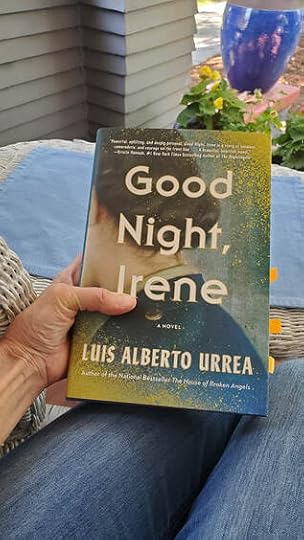 I could not have written this book because Luis Alberto Uurea based it on the true-life experiences of his mother, Phyllis Irene McLaughlin, who traveled across Europe with Patton's army. It's a great adventure story of women's strength, friendship and sacrifice.
I could not have written this book because Luis Alberto Uurea based it on the true-life experiences of his mother, Phyllis Irene McLaughlin, who traveled across Europe with Patton's army. It's a great adventure story of women's strength, friendship and sacrifice.
The fictional account follows closely the actual service route traveled by Phyllis and her partners Jill Pitts and Helen Anderson in the clubmobile Cheyanne. They saw Utah Beach, shortly after D-Day, skirmishes across France, where right in the middle of the Battle of Bastogne and the horrors of the Buchenwald death camp.
After reading the book, I had the honor of interviewing the author on stage for The Spokesman-Review’s Northwest Passages book club last week at the Bing Crosby Theater in downtown Spokane. Read more about that night here...  Luis Alberto Urrea answers a question from me at The Spokesman-Review’s Northwest Passages book club event July 6, 2023 at the Bing Crosby Theater in downtown Spokane, WA. The first Red Cross Clubmobile arrived in France just days after the D-Day invasion, and that summer, 80 of the modified two-and-a-half-ton GMC trucks trundled across the countryside serving the troops, not just refreshments, but music, laughter and dancing.
Luis Alberto Urrea answers a question from me at The Spokesman-Review’s Northwest Passages book club event July 6, 2023 at the Bing Crosby Theater in downtown Spokane, WA. The first Red Cross Clubmobile arrived in France just days after the D-Day invasion, and that summer, 80 of the modified two-and-a-half-ton GMC trucks trundled across the countryside serving the troops, not just refreshments, but music, laughter and dancing.
In their training before leaving the US, the women were taught how to let the soldiers win at board games, talk about baseball and provoke a smile. Over months at war, they became trustworthy listeners, as soldiers took them aside to confess broken hearts, or fear, or shame or guilt...whatever they had to get off their chest and had no one else they could talk to in the middle of a war.
During WWII, the women hated being called Donut Dollies, but since then, as their contributions to the war effort become more well-known and honored, the name had gained a deeper meaning. And clubmobilers, their official name, is so awkward.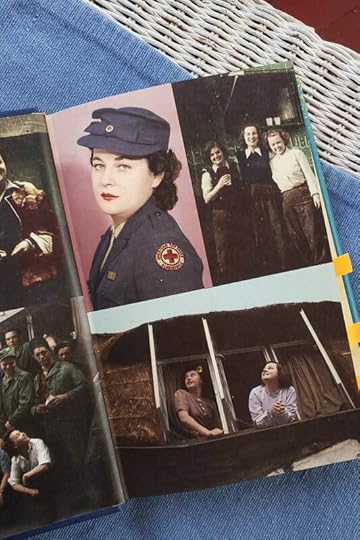 Photos on the fly leaves of the book show Phyllis Irene McLaughlin in her Red Cross uniform (top right) and Phyllis, Jill Pitts Knappenberger and Helen Anderson respectively (left to right) in front of the Cheyenne. (top left). Not unusual for the Red Cross women to find themselves behind enemy lines, as did Luis's mother, who hid in a barn covered with hay, while first German and then Russian soldiers attacked local women. She listened all night to their screams, so terrified, she prayed the soldiers would stay busy and not find her.
Photos on the fly leaves of the book show Phyllis Irene McLaughlin in her Red Cross uniform (top right) and Phyllis, Jill Pitts Knappenberger and Helen Anderson respectively (left to right) in front of the Cheyenne. (top left). Not unusual for the Red Cross women to find themselves behind enemy lines, as did Luis's mother, who hid in a barn covered with hay, while first German and then Russian soldiers attacked local women. She listened all night to their screams, so terrified, she prayed the soldiers would stay busy and not find her.
Luis said she could not forgive herself for that, and it became the root of nightmares later in life. Many nights as a teen, he was unable to sleep, hearing his mother's nightmares, her crying and yelling through the night.
"And it was not often what she’d seen but what she had heard. And I think that’s what damned her. I think that’s what she heard at night when she tried to sleep,” Luis told me.
Phyllis was serious injured at the end of the war, and suffered from physical pain along with what we now understand is Post Traumatic Stress.
Luis Alberto Uurea, is the author of more than twenty books including fiction, nonfiction and poetry, planned to write a nonfiction book on his mom's wartime experience until he found that fire had destroyed the WWII records. The project languished until he discovered (Jill Pitts) Knappenberger lived not a two-hour drive away. On a visit he discovered the 95-year-old had a great memory and a trove of letters, diaries and photos to supplement those of his mother.
"That's when the novel was born," he said.
In the novel, the character Irene is modeled on Phyllis and the character Dorothy stands in for Jill. But have hearing the author talk about the two women, it's difficult for me to separate the women from the characters in the story.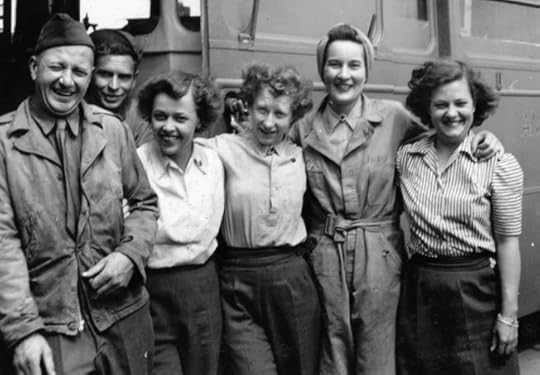 Phyllis at right and Jill, second from right, pose with the others in their crew and two soldiers. Friendship is at the crux of the novel. Two women from very different backgrounds, one from New York City, the other an Indiana farm woman, rub elbows in a tiny kitchen on wheels for days on end. At night they often sleep side by side under the truck because they are safer there if a bomb hits the truck.
Phyllis at right and Jill, second from right, pose with the others in their crew and two soldiers. Friendship is at the crux of the novel. Two women from very different backgrounds, one from New York City, the other an Indiana farm woman, rub elbows in a tiny kitchen on wheels for days on end. At night they often sleep side by side under the truck because they are safer there if a bomb hits the truck.
The women enjoyed their freedom far from home, had hilarious fun and faced the dangers of battle unarmed. Their friendship is forged in steel the day the Dorothy says to Irene:
"I think about my duty...and I think about you. We are all we have right now. You and me. I think about us getting through this...I will walk through fire for you. I need to know you will do the same for me...this is our story."
Irene embraced her friend. The two held each other, and though Irene wanted to speak, she could not. She trusted no words. But she trusted Dorothy to know what was true." pp. 149-150.
Below, to give you a picture, is the crew and driver of the Magnolia clubmobile "somewhere in Europe." They hauled their own water and gas tanks, regularly refilled by Army suppliers.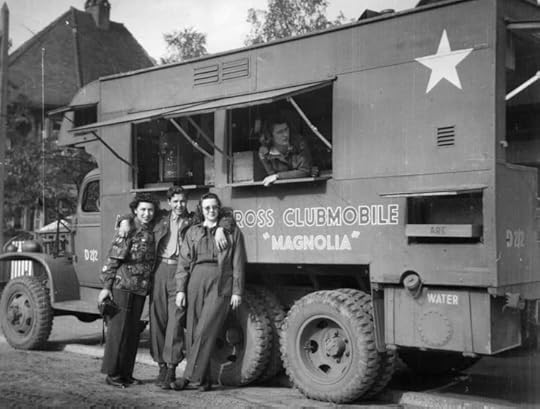 Thanks to Wendy over at the
The Butterfly Balcony
,
I have a few more photos showing the women in action.
Thanks to Wendy over at the
The Butterfly Balcony
,
I have a few more photos showing the women in action.  Above, the boys line up for service at the North Dakota.
Above, the boys line up for service at the North Dakota. 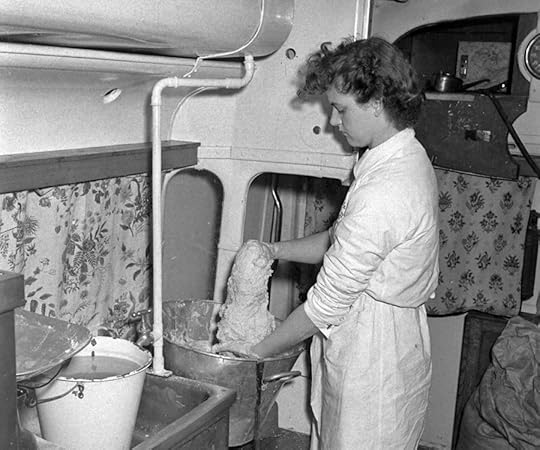 Virginia 'Ginny' Sherwood, Captain of the North Dakota crew Age 24, from Portland Oregon mixes the dough for donuts.
Virginia 'Ginny' Sherwood, Captain of the North Dakota crew Age 24, from Portland Oregon mixes the dough for donuts.  Dorothy 'Mike' Myrick, Age 24, Whiting, Indiana, and Katherine 'Tatty' Spaatz age 22 (no home state) select records to play on the Victrola and broadcast over the loudspeaker mounted on the outside of each truck. Note the rack of donuts ready to go at the left of the photo. More than 7,000 young women volunteered for service with the Red Cross during World War II. One enticement for some was that, unlike the Woman's Army and Navy corps, they were guaranteed service overseas.
Dorothy 'Mike' Myrick, Age 24, Whiting, Indiana, and Katherine 'Tatty' Spaatz age 22 (no home state) select records to play on the Victrola and broadcast over the loudspeaker mounted on the outside of each truck. Note the rack of donuts ready to go at the left of the photo. More than 7,000 young women volunteered for service with the Red Cross during World War II. One enticement for some was that, unlike the Woman's Army and Navy corps, they were guaranteed service overseas.
At the recent event in Spokane Luis Alberto Urrea said Good Night, Irene, "means “everything to me. I’ve put everything I know as a writer into it, and I’m comfortable knowing that I can’t reach this height again.”
Pulitzer Prize finalist Luis Alberto Uurea came through Spokane, WA, on tour publicizing his newest book Good Night, Irene.
Very soon after starting to read this novel, I wished that I had written it, or rather, written a nonfiction book about the Donut Dollies of World War II. These women served coffee, donuts and a slice of home to soldiers on the front lines of battle.
 I could not have written this book because Luis Alberto Uurea based it on the true-life experiences of his mother, Phyllis Irene McLaughlin, who traveled across Europe with Patton's army. It's a great adventure story of women's strength, friendship and sacrifice.
I could not have written this book because Luis Alberto Uurea based it on the true-life experiences of his mother, Phyllis Irene McLaughlin, who traveled across Europe with Patton's army. It's a great adventure story of women's strength, friendship and sacrifice.
The fictional account follows closely the actual service route traveled by Phyllis and her partners Jill Pitts and Helen Anderson in the clubmobile Cheyanne. They saw Utah Beach, shortly after D-Day, skirmishes across France, where right in the middle of the Battle of Bastogne and the horrors of the Buchenwald death camp.
After reading the book, I had the honor of interviewing the author on stage for The Spokesman-Review’s Northwest Passages book club last week at the Bing Crosby Theater in downtown Spokane. Read more about that night here...
 Luis Alberto Urrea answers a question from me at The Spokesman-Review’s Northwest Passages book club event July 6, 2023 at the Bing Crosby Theater in downtown Spokane, WA. The first Red Cross Clubmobile arrived in France just days after the D-Day invasion, and that summer, 80 of the modified two-and-a-half-ton GMC trucks trundled across the countryside serving the troops, not just refreshments, but music, laughter and dancing.
Luis Alberto Urrea answers a question from me at The Spokesman-Review’s Northwest Passages book club event July 6, 2023 at the Bing Crosby Theater in downtown Spokane, WA. The first Red Cross Clubmobile arrived in France just days after the D-Day invasion, and that summer, 80 of the modified two-and-a-half-ton GMC trucks trundled across the countryside serving the troops, not just refreshments, but music, laughter and dancing. In their training before leaving the US, the women were taught how to let the soldiers win at board games, talk about baseball and provoke a smile. Over months at war, they became trustworthy listeners, as soldiers took them aside to confess broken hearts, or fear, or shame or guilt...whatever they had to get off their chest and had no one else they could talk to in the middle of a war.
During WWII, the women hated being called Donut Dollies, but since then, as their contributions to the war effort become more well-known and honored, the name had gained a deeper meaning. And clubmobilers, their official name, is so awkward.
 Photos on the fly leaves of the book show Phyllis Irene McLaughlin in her Red Cross uniform (top right) and Phyllis, Jill Pitts Knappenberger and Helen Anderson respectively (left to right) in front of the Cheyenne. (top left). Not unusual for the Red Cross women to find themselves behind enemy lines, as did Luis's mother, who hid in a barn covered with hay, while first German and then Russian soldiers attacked local women. She listened all night to their screams, so terrified, she prayed the soldiers would stay busy and not find her.
Photos on the fly leaves of the book show Phyllis Irene McLaughlin in her Red Cross uniform (top right) and Phyllis, Jill Pitts Knappenberger and Helen Anderson respectively (left to right) in front of the Cheyenne. (top left). Not unusual for the Red Cross women to find themselves behind enemy lines, as did Luis's mother, who hid in a barn covered with hay, while first German and then Russian soldiers attacked local women. She listened all night to their screams, so terrified, she prayed the soldiers would stay busy and not find her. Luis said she could not forgive herself for that, and it became the root of nightmares later in life. Many nights as a teen, he was unable to sleep, hearing his mother's nightmares, her crying and yelling through the night.
"And it was not often what she’d seen but what she had heard. And I think that’s what damned her. I think that’s what she heard at night when she tried to sleep,” Luis told me.
Phyllis was serious injured at the end of the war, and suffered from physical pain along with what we now understand is Post Traumatic Stress.
Luis Alberto Uurea, is the author of more than twenty books including fiction, nonfiction and poetry, planned to write a nonfiction book on his mom's wartime experience until he found that fire had destroyed the WWII records. The project languished until he discovered (Jill Pitts) Knappenberger lived not a two-hour drive away. On a visit he discovered the 95-year-old had a great memory and a trove of letters, diaries and photos to supplement those of his mother.
"That's when the novel was born," he said.
In the novel, the character Irene is modeled on Phyllis and the character Dorothy stands in for Jill. But have hearing the author talk about the two women, it's difficult for me to separate the women from the characters in the story.
 Phyllis at right and Jill, second from right, pose with the others in their crew and two soldiers. Friendship is at the crux of the novel. Two women from very different backgrounds, one from New York City, the other an Indiana farm woman, rub elbows in a tiny kitchen on wheels for days on end. At night they often sleep side by side under the truck because they are safer there if a bomb hits the truck.
Phyllis at right and Jill, second from right, pose with the others in their crew and two soldiers. Friendship is at the crux of the novel. Two women from very different backgrounds, one from New York City, the other an Indiana farm woman, rub elbows in a tiny kitchen on wheels for days on end. At night they often sleep side by side under the truck because they are safer there if a bomb hits the truck.The women enjoyed their freedom far from home, had hilarious fun and faced the dangers of battle unarmed. Their friendship is forged in steel the day the Dorothy says to Irene:
"I think about my duty...and I think about you. We are all we have right now. You and me. I think about us getting through this...I will walk through fire for you. I need to know you will do the same for me...this is our story."
Irene embraced her friend. The two held each other, and though Irene wanted to speak, she could not. She trusted no words. But she trusted Dorothy to know what was true." pp. 149-150.
Below, to give you a picture, is the crew and driver of the Magnolia clubmobile "somewhere in Europe." They hauled their own water and gas tanks, regularly refilled by Army suppliers.
 Thanks to Wendy over at the
The Butterfly Balcony
,
I have a few more photos showing the women in action.
Thanks to Wendy over at the
The Butterfly Balcony
,
I have a few more photos showing the women in action.  Above, the boys line up for service at the North Dakota.
Above, the boys line up for service at the North Dakota.  Virginia 'Ginny' Sherwood, Captain of the North Dakota crew Age 24, from Portland Oregon mixes the dough for donuts.
Virginia 'Ginny' Sherwood, Captain of the North Dakota crew Age 24, from Portland Oregon mixes the dough for donuts.  Dorothy 'Mike' Myrick, Age 24, Whiting, Indiana, and Katherine 'Tatty' Spaatz age 22 (no home state) select records to play on the Victrola and broadcast over the loudspeaker mounted on the outside of each truck. Note the rack of donuts ready to go at the left of the photo. More than 7,000 young women volunteered for service with the Red Cross during World War II. One enticement for some was that, unlike the Woman's Army and Navy corps, they were guaranteed service overseas.
Dorothy 'Mike' Myrick, Age 24, Whiting, Indiana, and Katherine 'Tatty' Spaatz age 22 (no home state) select records to play on the Victrola and broadcast over the loudspeaker mounted on the outside of each truck. Note the rack of donuts ready to go at the left of the photo. More than 7,000 young women volunteered for service with the Red Cross during World War II. One enticement for some was that, unlike the Woman's Army and Navy corps, they were guaranteed service overseas.At the recent event in Spokane Luis Alberto Urrea said Good Night, Irene, "means “everything to me. I’ve put everything I know as a writer into it, and I’m comfortable knowing that I can’t reach this height again.”
Published on August 01, 2023 13:09
July 6, 2023
The Only American Executed on Direct Orders from Hitler
"Ich habe Deutschland auch so geliebt."
"And I have loved Germany so much.” The last words spoken by Mildred Fish-Harnack.
Though she died in Germany, Mildred was an American. A courageous woman of her convictions, the only American executed on direct orders from Hitler. The United States government tried to cover up her story for decades because an officer in the Army Counterintelligence Corps believed she was a communist. With this story comes the question: how is it that American woman started the largest anti-Nazi resistance group in Berlin and we're only hearing about her now?Mildred Fish, a writer and literature teacher, grew up near “Sauerkraut Boulevard” on the west side of Milwaukee, Wisconsin. She was an active teenager playing basketball and baseball, editing the school newspaper and acting in her senior class play.
With this story comes the question: how is it that American woman started the largest anti-Nazi resistance group in Berlin and we're only hearing about her now?Mildred Fish, a writer and literature teacher, grew up near “Sauerkraut Boulevard” on the west side of Milwaukee, Wisconsin. She was an active teenager playing basketball and baseball, editing the school newspaper and acting in her senior class play.
Mildred started down the road less traveled after a chance meeting with a German exchange student as a graduate student at the University of Wisconsin. Arvid Harnack ended up in her class by accident.
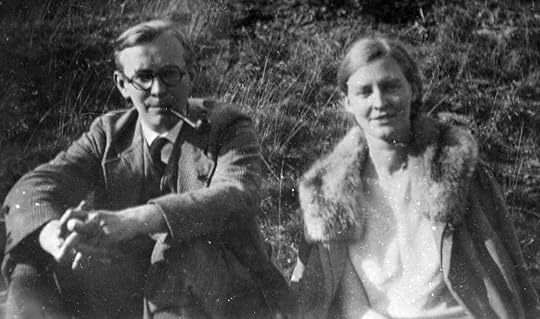 Mildred and Arvid Harnack in Jena, Germany, 1929 (Courtesy of Gedenkstätte Deutscher Widerstand)There's some discrepancy among sources as to whether Mildred had learned German growing up. I'm going with a supposed letter Arvid wrote his mother, June 8, 1926.
Mildred and Arvid Harnack in Jena, Germany, 1929 (Courtesy of Gedenkstätte Deutscher Widerstand)There's some discrepancy among sources as to whether Mildred had learned German growing up. I'm going with a supposed letter Arvid wrote his mother, June 8, 1926.
“I am very happy. I’ve got engaged. The whole thing is actually very curious because I can hardly speak English and Mildred knows no German. I made up my mind when I saw her for the second time. We got engaged yesterday.”
When they married several months later, Mildred hyphenated her name, Fish-Harnack. She finished her Master of Arts and the couple moved to Germany in 1929.
By 1931, Mildred Harnack was studying for her doctorate at the University of Berlin and teaching American Literature, acquainting German students with the likes of Emerson, Whitman, Theodore Dreiser, and George Bernard Shaw.
Her students liked her; class enrollment tripled over three semesters. The administration, however, did not like her views about the Nazi party. After the following semester, she lost her position.
By the fall of 1932, Mildred got a job teaching adults at a night school. She started holding meetings at her and Arvid's apartment, recruiting some of her students to help find ways to combat Nazi influence in the city. Propaganda poster at the facade of a building in the Wilhemstrasse, Berlin 1932.They worked in secret, their only defense against Hitler's rising power—paper and words. They published an underground newspaper criticizing the Nazi regime and distributed it throughout the city. Several members of the group caught in possession of illegal literature were sent to concentration camps.
Propaganda poster at the facade of a building in the Wilhemstrasse, Berlin 1932.They worked in secret, their only defense against Hitler's rising power—paper and words. They published an underground newspaper criticizing the Nazi regime and distributed it throughout the city. Several members of the group caught in possession of illegal literature were sent to concentration camps.
Mildred had the means to come home to America, but she stayed for decade, working with other anti-Nazi groups including the extended family of Dietrich Bonhoeffer. By 1940, Mildred and Arvid were leading the largest underground resistance organization in Berlin.
Members spied for the U.S. and Soviet embassies, and after Germany invaded Russia, passed military intelligence to Moscow. In 1942, German radio counterintelligence intercepted and decoded radio transmissions that revealed the names of the group.
Mildred and Arvid were arrested in September 1942.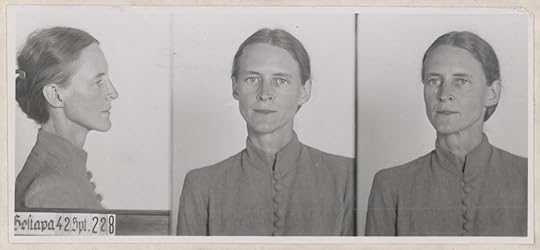 The Gestapo mugshot for Mildred Harnack following her arrest in 1942. (Bundesarchiv, R58 Bild-03191-228)After a four-day trial in mid-December, the couple was convicted by a Nazi military court. At that time, Mildred received a six-year prison sentence, while Arvid, convicted of high treason and espionage, was sentenced to death.
The Gestapo mugshot for Mildred Harnack following her arrest in 1942. (Bundesarchiv, R58 Bild-03191-228)After a four-day trial in mid-December, the couple was convicted by a Nazi military court. At that time, Mildred received a six-year prison sentence, while Arvid, convicted of high treason and espionage, was sentenced to death.
As he awaited execution, he wrote his wife. “Can you remember Picnic Point, when we got engaged? ...our first serious talk at lunch in a restaurant in State Street? That talk became my guiding star and has remained so.... “You are in my heart…My greatest wish is that you are happy when you think of me. I am when I think of you. Many, many kisses! I hug you tight. Your A.”
Several days later Arvid was hanged, never knowing that Hitler would intervene in his wife's case.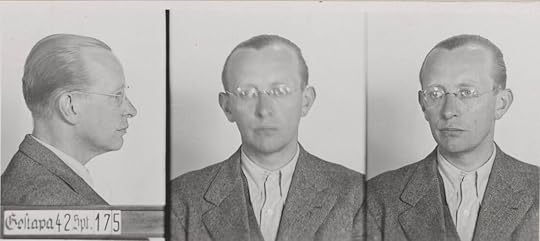 Gestapo mug shots of Arvid following his arrest, 1942 (Bundesarchiv, R 58/03191-175)When Hitler was told of Mildred's sentence, he ordered a new trial and this time, like Arvid, she was sentenced to death. February 16, 1943, Mildred was tied down and guillotined. The Nazis recorded that it took her seven seconds to die.
Gestapo mug shots of Arvid following his arrest, 1942 (Bundesarchiv, R 58/03191-175)When Hitler was told of Mildred's sentence, he ordered a new trial and this time, like Arvid, she was sentenced to death. February 16, 1943, Mildred was tied down and guillotined. The Nazis recorded that it took her seven seconds to die.
So why was Mildred's story concealed in classified documents? Why was she not celebrated like other heroines of Nazi resistance?
An officer in the U.S. Army Counterintelligence Corps believed Mildred was a communist because she gave information to the Soviets during the war. He wrote a memo saying, in so many words, she deserved her punishment.
Mildred was remembered by those who had known her at the University of Wisconsin. In 1947, they recognized her in their alumni magazine. A plan to honor Mildren more publicly was quashed. As a UW documentary explained: “Wisconsin senator Joe McCarthy and his hunt for Communists may have been a factor. So instead of honoring Mildred, the university’s inquiry triggered an FBI investigation.”
The full story is coming out now. One of Mildred's descendants, a great-great-niece, Rebecca Donner has combed through archives in the US, the UK, Germany and Russia to write a book. A very personal book.
"My first memory of hearing [Mildred's] name was when I was about 9 years old." Rebecca Donner told NPR. "And my great-grandmother in Chevy Chase, Md., was measuring my height on the kitchen wall, and when I stepped back...I saw an M, and I thought, who is she?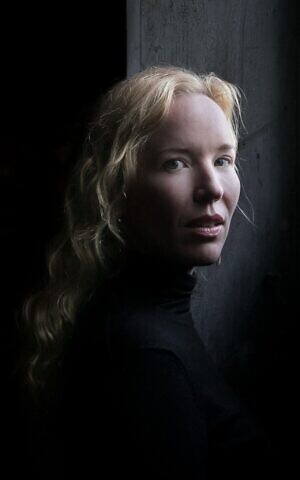 Rebecca Donner (Beowulf Sheehan)
And my great-grandmother said, well, that's Mildred. I wanted to hear more, but - she was not forthcoming. And at the age of 9, I thought, well, there's a mystery here. And later, when I was a teenager - when I was about 16 - my grandmother gave me Mildred's letters."
Rebecca Donner (Beowulf Sheehan)
And my great-grandmother said, well, that's Mildred. I wanted to hear more, but - she was not forthcoming. And at the age of 9, I thought, well, there's a mystery here. And later, when I was a teenager - when I was about 16 - my grandmother gave me Mildred's letters."
The book by Author Rebecca Donner is called All the Frequent Troubles of Our Days: The True Story of the American Woman at the Heart of the German Resistance to Hitler.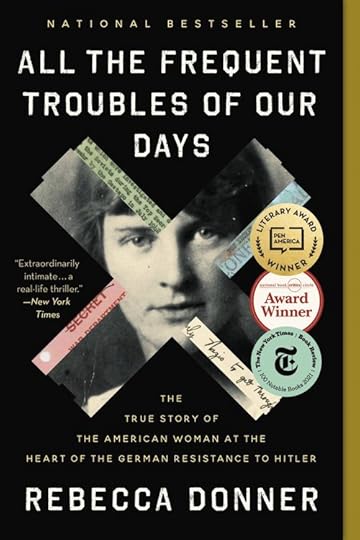 According to the The New York Times review:
According to the The New York Times review:
"The book about Harnack’s life and death turns out to be wilder and more expansive than a standard-issue biography. Donner is Harnack’s great-great-niece, so this is a family history too. It is also a story of code names and dead drops, a real-life thriller with a cruel ending — not to mention an account of Hitler’s ascent from attention-seeking buffoon to genocidal Führer."
Like my article today? Please share: Sources
https://www.npr.org/2021/08/22/1027830968/rebecca-donner-tells-the-story-of-her-great-great-aunt
https://news.wisc.edu/mildred-fish-harnack-honored-as-hero-of-resistance-to-nazi-regime/
https://www.timesofisrael.com/a-courageous-american-woman-led-the-largest-resistance-group-in-nazi-germany/
"And I have loved Germany so much.” The last words spoken by Mildred Fish-Harnack.
Though she died in Germany, Mildred was an American. A courageous woman of her convictions, the only American executed on direct orders from Hitler. The United States government tried to cover up her story for decades because an officer in the Army Counterintelligence Corps believed she was a communist.
 With this story comes the question: how is it that American woman started the largest anti-Nazi resistance group in Berlin and we're only hearing about her now?Mildred Fish, a writer and literature teacher, grew up near “Sauerkraut Boulevard” on the west side of Milwaukee, Wisconsin. She was an active teenager playing basketball and baseball, editing the school newspaper and acting in her senior class play.
With this story comes the question: how is it that American woman started the largest anti-Nazi resistance group in Berlin and we're only hearing about her now?Mildred Fish, a writer and literature teacher, grew up near “Sauerkraut Boulevard” on the west side of Milwaukee, Wisconsin. She was an active teenager playing basketball and baseball, editing the school newspaper and acting in her senior class play.Mildred started down the road less traveled after a chance meeting with a German exchange student as a graduate student at the University of Wisconsin. Arvid Harnack ended up in her class by accident.
 Mildred and Arvid Harnack in Jena, Germany, 1929 (Courtesy of Gedenkstätte Deutscher Widerstand)There's some discrepancy among sources as to whether Mildred had learned German growing up. I'm going with a supposed letter Arvid wrote his mother, June 8, 1926.
Mildred and Arvid Harnack in Jena, Germany, 1929 (Courtesy of Gedenkstätte Deutscher Widerstand)There's some discrepancy among sources as to whether Mildred had learned German growing up. I'm going with a supposed letter Arvid wrote his mother, June 8, 1926.“I am very happy. I’ve got engaged. The whole thing is actually very curious because I can hardly speak English and Mildred knows no German. I made up my mind when I saw her for the second time. We got engaged yesterday.”
When they married several months later, Mildred hyphenated her name, Fish-Harnack. She finished her Master of Arts and the couple moved to Germany in 1929.
By 1931, Mildred Harnack was studying for her doctorate at the University of Berlin and teaching American Literature, acquainting German students with the likes of Emerson, Whitman, Theodore Dreiser, and George Bernard Shaw.
Her students liked her; class enrollment tripled over three semesters. The administration, however, did not like her views about the Nazi party. After the following semester, she lost her position.
By the fall of 1932, Mildred got a job teaching adults at a night school. She started holding meetings at her and Arvid's apartment, recruiting some of her students to help find ways to combat Nazi influence in the city.
 Propaganda poster at the facade of a building in the Wilhemstrasse, Berlin 1932.They worked in secret, their only defense against Hitler's rising power—paper and words. They published an underground newspaper criticizing the Nazi regime and distributed it throughout the city. Several members of the group caught in possession of illegal literature were sent to concentration camps.
Propaganda poster at the facade of a building in the Wilhemstrasse, Berlin 1932.They worked in secret, their only defense against Hitler's rising power—paper and words. They published an underground newspaper criticizing the Nazi regime and distributed it throughout the city. Several members of the group caught in possession of illegal literature were sent to concentration camps.
Mildred had the means to come home to America, but she stayed for decade, working with other anti-Nazi groups including the extended family of Dietrich Bonhoeffer. By 1940, Mildred and Arvid were leading the largest underground resistance organization in Berlin.
Members spied for the U.S. and Soviet embassies, and after Germany invaded Russia, passed military intelligence to Moscow. In 1942, German radio counterintelligence intercepted and decoded radio transmissions that revealed the names of the group.
Mildred and Arvid were arrested in September 1942.
 The Gestapo mugshot for Mildred Harnack following her arrest in 1942. (Bundesarchiv, R58 Bild-03191-228)After a four-day trial in mid-December, the couple was convicted by a Nazi military court. At that time, Mildred received a six-year prison sentence, while Arvid, convicted of high treason and espionage, was sentenced to death.
The Gestapo mugshot for Mildred Harnack following her arrest in 1942. (Bundesarchiv, R58 Bild-03191-228)After a four-day trial in mid-December, the couple was convicted by a Nazi military court. At that time, Mildred received a six-year prison sentence, while Arvid, convicted of high treason and espionage, was sentenced to death.As he awaited execution, he wrote his wife. “Can you remember Picnic Point, when we got engaged? ...our first serious talk at lunch in a restaurant in State Street? That talk became my guiding star and has remained so.... “You are in my heart…My greatest wish is that you are happy when you think of me. I am when I think of you. Many, many kisses! I hug you tight. Your A.”
Several days later Arvid was hanged, never knowing that Hitler would intervene in his wife's case.
 Gestapo mug shots of Arvid following his arrest, 1942 (Bundesarchiv, R 58/03191-175)When Hitler was told of Mildred's sentence, he ordered a new trial and this time, like Arvid, she was sentenced to death. February 16, 1943, Mildred was tied down and guillotined. The Nazis recorded that it took her seven seconds to die.
Gestapo mug shots of Arvid following his arrest, 1942 (Bundesarchiv, R 58/03191-175)When Hitler was told of Mildred's sentence, he ordered a new trial and this time, like Arvid, she was sentenced to death. February 16, 1943, Mildred was tied down and guillotined. The Nazis recorded that it took her seven seconds to die.So why was Mildred's story concealed in classified documents? Why was she not celebrated like other heroines of Nazi resistance?
An officer in the U.S. Army Counterintelligence Corps believed Mildred was a communist because she gave information to the Soviets during the war. He wrote a memo saying, in so many words, she deserved her punishment.
Mildred was remembered by those who had known her at the University of Wisconsin. In 1947, they recognized her in their alumni magazine. A plan to honor Mildren more publicly was quashed. As a UW documentary explained: “Wisconsin senator Joe McCarthy and his hunt for Communists may have been a factor. So instead of honoring Mildred, the university’s inquiry triggered an FBI investigation.”
The full story is coming out now. One of Mildred's descendants, a great-great-niece, Rebecca Donner has combed through archives in the US, the UK, Germany and Russia to write a book. A very personal book.
"My first memory of hearing [Mildred's] name was when I was about 9 years old." Rebecca Donner told NPR. "And my great-grandmother in Chevy Chase, Md., was measuring my height on the kitchen wall, and when I stepped back...I saw an M, and I thought, who is she?
 Rebecca Donner (Beowulf Sheehan)
And my great-grandmother said, well, that's Mildred. I wanted to hear more, but - she was not forthcoming. And at the age of 9, I thought, well, there's a mystery here. And later, when I was a teenager - when I was about 16 - my grandmother gave me Mildred's letters."
Rebecca Donner (Beowulf Sheehan)
And my great-grandmother said, well, that's Mildred. I wanted to hear more, but - she was not forthcoming. And at the age of 9, I thought, well, there's a mystery here. And later, when I was a teenager - when I was about 16 - my grandmother gave me Mildred's letters."
The book by Author Rebecca Donner is called All the Frequent Troubles of Our Days: The True Story of the American Woman at the Heart of the German Resistance to Hitler.
 According to the The New York Times review:
According to the The New York Times review:
"The book about Harnack’s life and death turns out to be wilder and more expansive than a standard-issue biography. Donner is Harnack’s great-great-niece, so this is a family history too. It is also a story of code names and dead drops, a real-life thriller with a cruel ending — not to mention an account of Hitler’s ascent from attention-seeking buffoon to genocidal Führer."
Like my article today? Please share: Sources
https://www.npr.org/2021/08/22/1027830968/rebecca-donner-tells-the-story-of-her-great-great-aunt
https://news.wisc.edu/mildred-fish-harnack-honored-as-hero-of-resistance-to-nazi-regime/
https://www.timesofisrael.com/a-courageous-american-woman-led-the-largest-resistance-group-in-nazi-germany/
Published on July 06, 2023 14:48
March 21, 2023
Her Typing Skills May have Saved her Future-Husband's Life
I spend a good chunk of my time digging into the past, finding the names of women who deserve to be remembered and telling their stories.
I love it when those stories take interesting twists and turns like Arlene Robert's. Her skill lies behind one of the biggest events in the history of humankind. She played a very tiny part, as did many women whose names we'll never know.
We know Arlene's, in part, because her boyfriend painted her name on his fighter plane and survived WWII to tell about it.
Arlene Roberts was much more than a pretty face.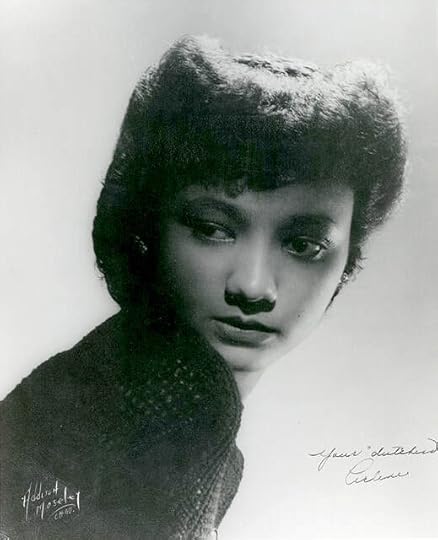 "Dutchess" Arlene Roberts, Moline, Illinoi, 1953 On summer break from the State University of Iowa in 1945, Arlene took a secretarial job at the University of Chicago. Assigned to the general pool of typists, Arlene distinguished herself for speed and accuracy and earned a promotion to an elite group of women working at the laboratory at the university's School of Metallurgy.
"Dutchess" Arlene Roberts, Moline, Illinoi, 1953 On summer break from the State University of Iowa in 1945, Arlene took a secretarial job at the University of Chicago. Assigned to the general pool of typists, Arlene distinguished herself for speed and accuracy and earned a promotion to an elite group of women working at the laboratory at the university's School of Metallurgy.
The typists worked for several weeks on what they were told was a top-secret project. Even some of the scientists in the lab didn't know what it was. Arlene typed complicated scientific equations that made no sense to her on a strange aluminum-foil type paper. As the job came to a close, she was sequestered to type the final project plans.
"When they announced we had been working on the atomic bomb, both scientists and staff members broke down and cried over what this horrible weapon could do," she remembered later. "We also knew that its use might be necessary to end the war."
Meanwhile, a young soldier, James "Braddie" Morris was fighting the Japanese in the South Pacific. He had been, that is, until he came down a case of malaria that nearly killed him.
Below: James "Braddie" Morris. (Iowa University Digital Library)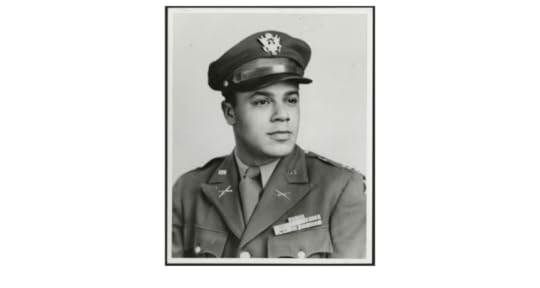 James Morris, Jr, had proven himself, and helped desegregate the 6th Army "Alamo Force" a small unit of skilled men with specialized reconnaissance expertise.
James Morris, Jr, had proven himself, and helped desegregate the 6th Army "Alamo Force" a small unit of skilled men with specialized reconnaissance expertise.
They acted as scouts, infiltrating enemy territory, sometimes swimming ashore to gather information before a battle. As the United States stood on standby preparing to invade the Japanese mainland, army intelligence predicted one million American men would be dead or wounded.
Morris had recovered from malaria and would be a forward scout, his unit chosen to make the first amphibious landing.
The US dropped the atomic bomb on Hiroshima, Japan, August 6, 1945, killing 140,000 people. The second bomb dropped on Nagasaki three days later killed 80,000 and forced the Japanese to surrender.
The invasion was cancelled, and James Morris and his unit survived the war and went home. The following year he met Arlene at the University of Iowa.
But it was another man who made Arlene's name famous during the war, and it was not for her contribution to the Manhattan Project that possible saved her future husband's life. That was a Tuskegee Airman, Captain Robert W. Williams who was shooting down German planes over Europe with the 332nd Fighter Group.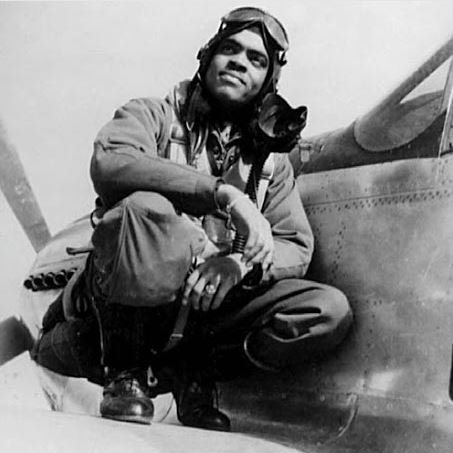 Tuskegee Airman, Captain Robert W. Williams Before the war, back in Davenport, Iowa, Robert Williams drove a little yellow convertible, catching the eye of of all the girls. But it was high school senior Arlene Roberts who he gave a ride home from school.
Tuskegee Airman, Captain Robert W. Williams Before the war, back in Davenport, Iowa, Robert Williams drove a little yellow convertible, catching the eye of of all the girls. But it was high school senior Arlene Roberts who he gave a ride home from school.
When the war broke out, Robert left for Alabama to enroll in the Negro Pilot Training Program at the Tuskegee Institute. He wrote home to Arlene and she sent him a glamor shot of herself signed, Your 'Dutchess' Arlene.
When he finished training, Robert went to Italy where he flew a P-51D Mustang fighter. Like all the pilots, he painted something personal on his plane, Your 'Dutchess' Arlene, right on the nose. You can't see it in the photo below, but there's replica installed outside the Des Moines airport.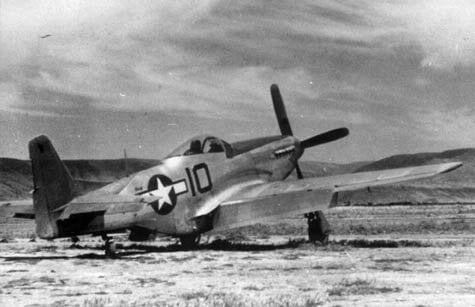 WWII P-51D Mustang In March 1944, Captain Williams and the P-51D shot down one of the Luftwaffe’s Me 262 jet fighters and a pair of Fw 190s.
WWII P-51D Mustang In March 1944, Captain Williams and the P-51D shot down one of the Luftwaffe’s Me 262 jet fighters and a pair of Fw 190s.
He didn't get the girl, but was awarded the Distinguished Flying Cross, the Air Medal with six oak leaf clusters, and the Presidential Distinguished Unit Citation, among others. And he was played by Laurence Fishburne in the HBO feature The Tuskegee Airman (1995) for which he had written the screenplay.
James Morris, Jr., our hero from the war in the Pacific won four bronze stars and came home to finish his law studies at the University of Iowa, where he and Arlene Roberts fell in love and married.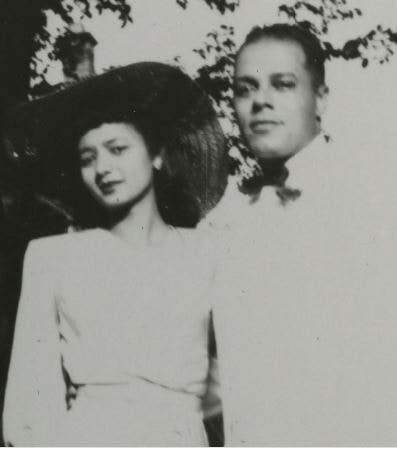 Arlene and James Morris, Jr. The couple raised three sons in Des Moines, where he became the first black assistant county attorney.
Arlene and James Morris, Jr. The couple raised three sons in Des Moines, where he became the first black assistant county attorney. 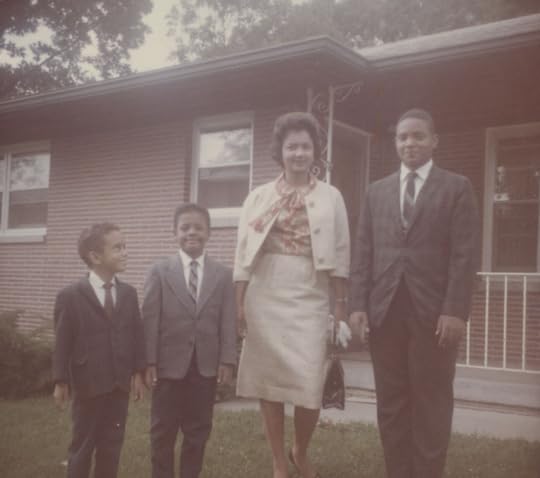 Des Moines was segregated socially, after raising her boys, Arlene became active with a group of women, different races and different religions, who worked to end prejudice, not only in their neighborhood and city, but across the country.
Des Moines was segregated socially, after raising her boys, Arlene became active with a group of women, different races and different religions, who worked to end prejudice, not only in their neighborhood and city, but across the country.
They traveled thousands of miles telling their personal stories. In a 1964 interview Arlene said, “In order to do a good job, I must break the habit of a lifetime—that of keeping my true and hurt feelings hidden."
Arlene spoke about her grade-school teacher who used the n-word in class when talking about slavery and who she feared that her sons would suffer psychological scars from the racism they encountered.
A fellow panelist and Des Moines philanthropist Maddie Levitt said of Arlene “I think she is a quiet giant. She does her thing without a lot of outside approval.”
Definitely more than a pretty face.
Like my article today? Please tweet! Sources
https://www.facebook.com/aeroshipyard/posts/1308224312933795
https://cafriseabove.org/artifact/duchess-arlene/
https://cafriseabove.org/robert-w-williams/
ttps://digital.lib.uiowa.edu/islandora/object/ui%3Ajamesmorris_88 https://digital.lib.uiowa.edu/islandora/object/ui%3Aaawiowa_1296
https://digital.lib.uiowa.edu/islandora/object/ui%3Aaawiowa_1297
Des Moines Register and Tribune Company, "'Duchess Arlene' soars above race," February 21, 2006.
Morris, Robert V., Black Faces of War: A Legacy of Honor from the American Revolution to Today, Zenith Press.
I love it when those stories take interesting twists and turns like Arlene Robert's. Her skill lies behind one of the biggest events in the history of humankind. She played a very tiny part, as did many women whose names we'll never know.
We know Arlene's, in part, because her boyfriend painted her name on his fighter plane and survived WWII to tell about it.
Arlene Roberts was much more than a pretty face.
 "Dutchess" Arlene Roberts, Moline, Illinoi, 1953 On summer break from the State University of Iowa in 1945, Arlene took a secretarial job at the University of Chicago. Assigned to the general pool of typists, Arlene distinguished herself for speed and accuracy and earned a promotion to an elite group of women working at the laboratory at the university's School of Metallurgy.
"Dutchess" Arlene Roberts, Moline, Illinoi, 1953 On summer break from the State University of Iowa in 1945, Arlene took a secretarial job at the University of Chicago. Assigned to the general pool of typists, Arlene distinguished herself for speed and accuracy and earned a promotion to an elite group of women working at the laboratory at the university's School of Metallurgy. The typists worked for several weeks on what they were told was a top-secret project. Even some of the scientists in the lab didn't know what it was. Arlene typed complicated scientific equations that made no sense to her on a strange aluminum-foil type paper. As the job came to a close, she was sequestered to type the final project plans.
"When they announced we had been working on the atomic bomb, both scientists and staff members broke down and cried over what this horrible weapon could do," she remembered later. "We also knew that its use might be necessary to end the war."
Meanwhile, a young soldier, James "Braddie" Morris was fighting the Japanese in the South Pacific. He had been, that is, until he came down a case of malaria that nearly killed him.
Below: James "Braddie" Morris. (Iowa University Digital Library)
 James Morris, Jr, had proven himself, and helped desegregate the 6th Army "Alamo Force" a small unit of skilled men with specialized reconnaissance expertise.
James Morris, Jr, had proven himself, and helped desegregate the 6th Army "Alamo Force" a small unit of skilled men with specialized reconnaissance expertise. They acted as scouts, infiltrating enemy territory, sometimes swimming ashore to gather information before a battle. As the United States stood on standby preparing to invade the Japanese mainland, army intelligence predicted one million American men would be dead or wounded.
Morris had recovered from malaria and would be a forward scout, his unit chosen to make the first amphibious landing.
The US dropped the atomic bomb on Hiroshima, Japan, August 6, 1945, killing 140,000 people. The second bomb dropped on Nagasaki three days later killed 80,000 and forced the Japanese to surrender.
The invasion was cancelled, and James Morris and his unit survived the war and went home. The following year he met Arlene at the University of Iowa.
But it was another man who made Arlene's name famous during the war, and it was not for her contribution to the Manhattan Project that possible saved her future husband's life. That was a Tuskegee Airman, Captain Robert W. Williams who was shooting down German planes over Europe with the 332nd Fighter Group.
 Tuskegee Airman, Captain Robert W. Williams Before the war, back in Davenport, Iowa, Robert Williams drove a little yellow convertible, catching the eye of of all the girls. But it was high school senior Arlene Roberts who he gave a ride home from school.
Tuskegee Airman, Captain Robert W. Williams Before the war, back in Davenport, Iowa, Robert Williams drove a little yellow convertible, catching the eye of of all the girls. But it was high school senior Arlene Roberts who he gave a ride home from school.When the war broke out, Robert left for Alabama to enroll in the Negro Pilot Training Program at the Tuskegee Institute. He wrote home to Arlene and she sent him a glamor shot of herself signed, Your 'Dutchess' Arlene.
When he finished training, Robert went to Italy where he flew a P-51D Mustang fighter. Like all the pilots, he painted something personal on his plane, Your 'Dutchess' Arlene, right on the nose. You can't see it in the photo below, but there's replica installed outside the Des Moines airport.
 WWII P-51D Mustang In March 1944, Captain Williams and the P-51D shot down one of the Luftwaffe’s Me 262 jet fighters and a pair of Fw 190s.
WWII P-51D Mustang In March 1944, Captain Williams and the P-51D shot down one of the Luftwaffe’s Me 262 jet fighters and a pair of Fw 190s. He didn't get the girl, but was awarded the Distinguished Flying Cross, the Air Medal with six oak leaf clusters, and the Presidential Distinguished Unit Citation, among others. And he was played by Laurence Fishburne in the HBO feature The Tuskegee Airman (1995) for which he had written the screenplay.
James Morris, Jr., our hero from the war in the Pacific won four bronze stars and came home to finish his law studies at the University of Iowa, where he and Arlene Roberts fell in love and married.
 Arlene and James Morris, Jr. The couple raised three sons in Des Moines, where he became the first black assistant county attorney.
Arlene and James Morris, Jr. The couple raised three sons in Des Moines, where he became the first black assistant county attorney.  Des Moines was segregated socially, after raising her boys, Arlene became active with a group of women, different races and different religions, who worked to end prejudice, not only in their neighborhood and city, but across the country.
Des Moines was segregated socially, after raising her boys, Arlene became active with a group of women, different races and different religions, who worked to end prejudice, not only in their neighborhood and city, but across the country.They traveled thousands of miles telling their personal stories. In a 1964 interview Arlene said, “In order to do a good job, I must break the habit of a lifetime—that of keeping my true and hurt feelings hidden."
Arlene spoke about her grade-school teacher who used the n-word in class when talking about slavery and who she feared that her sons would suffer psychological scars from the racism they encountered.
A fellow panelist and Des Moines philanthropist Maddie Levitt said of Arlene “I think she is a quiet giant. She does her thing without a lot of outside approval.”
Definitely more than a pretty face.
Like my article today? Please tweet! Sources
https://www.facebook.com/aeroshipyard/posts/1308224312933795
https://cafriseabove.org/artifact/duchess-arlene/
https://cafriseabove.org/robert-w-williams/
ttps://digital.lib.uiowa.edu/islandora/object/ui%3Ajamesmorris_88 https://digital.lib.uiowa.edu/islandora/object/ui%3Aaawiowa_1296
https://digital.lib.uiowa.edu/islandora/object/ui%3Aaawiowa_1297
Des Moines Register and Tribune Company, "'Duchess Arlene' soars above race," February 21, 2006.
Morris, Robert V., Black Faces of War: A Legacy of Honor from the American Revolution to Today, Zenith Press.
Published on March 21, 2023 12:56
February 27, 2023
Tour of Transformation: From Mennonite Farm to the Skies of War
Courage wears many different faces, as shown in the varied stories I've sent you, as well as in my books.
This week, one woman's story moves a step beyond, showing how courage can lead to transformation.
Patty Bear grew up in the Mennonite faith which holds pacificism as a foundational belief, but the cruel truth? Violence ruled her home and family.
In retrospect, she called her father a "domestic terrorist" who abused her mother for years. But when he questioned Mennonite leaders and was excommunicated, the media portrayed him as the victim , a man shunned by his wife and children.
Patty went from her sheltered, rural life where her father regarded her mother as property, like another animal on his farm, to becoming a pioneering woman pilot in the United States Air Force.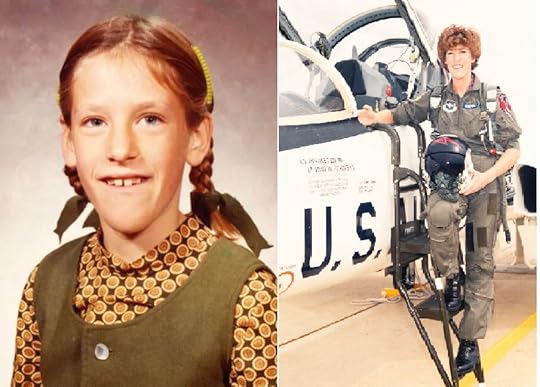 (Left) Patty in second grade. (At right) Patty in pilot training alongside the supersonic T-38. That's transformation!
(Left) Patty in second grade. (At right) Patty in pilot training alongside the supersonic T-38. That's transformation!
Patty agreed to tell her story for us this week.
Patricia Bear: Soaring to Freedom
Transformation is a lovely concept, but someone should warn us it won’t just change our circumstances, it will change who we are. And that will be a terrifying journey into the unknown. The high school loudspeaker blared an announcement that a cadet from the US Air Force Academy would make a presentation. I did not know what this place was. My best guess was, maybe it had something to do with flying?
Out of dire necessity, we had migrated from our small, rural school to this much larger school, where I still felt wildly out of place in this “worldly” world where people took for granted things I had never heard of and where I was acutely aware of my family’s differentness.
Growing up among the insular Plain People in an Old Order Mennonite community where voting, “going to the law”, and serving in the military were strictly forbidden. Where “worldly” jobs like pilot or real estate agent were prohibited for men who might get corrupted by exposure to the temptations of the outside world. Where women’s highest allowed ambition was to mother a large brood of children or perhaps run a business with their husband. Patty's mother (center back) heading into one of the several court cases. Excommunication and shunning had suddenly and dramatically upended our isolated but mostly bucolic farm life. It had ignited a decade of living on the run from violence while dodging local and national reporters and the searing publicity that accompanied our story and its court cases, one of which went to the PA Supreme Court.
Patty's mother (center back) heading into one of the several court cases. Excommunication and shunning had suddenly and dramatically upended our isolated but mostly bucolic farm life. It had ignited a decade of living on the run from violence while dodging local and national reporters and the searing publicity that accompanied our story and its court cases, one of which went to the PA Supreme Court.
Years passed, I felt trapped in a nightmare with no ending. But I was trying to wake up. Trying to escape the gravity I had been born into.
On the morning of the mysterious announcement, uncharacteristically having nothing to do in the next period study hall, I shrugged my shoulders and thought, “why not check this out?” Forty-five minutes later, I emerged dazed, but utterly sure that this wildly unforeseen possibility was my answer.
Flying would become my ticket to liberation, and the military, as it has been for so many, would be my transportation to the entire world.
Though I had been taking concrete steps forward, I wouldn’t realize until years later the importance of dreaming, planning, and thinking. These subtle, internal efforts were slowly chipping away at my old self. Chipping away at the heavy indoctrinations I carried. And when I became just barely light enough, a door opened, and I flew out into a new world.  Patty Bear in her US Air Force Academy graduation photo. In some ways, this new world was all too familiar: overtly male centered, heavy indoctrination, highly regimented, and rigid.
Patty Bear in her US Air Force Academy graduation photo. In some ways, this new world was all too familiar: overtly male centered, heavy indoctrination, highly regimented, and rigid.
After years of the publicity frenzy surrounding our family along with my mother’s distinctive Plain clothes and black bonnet relentlessly exposing our presence, I craved the anonymity of being sixteen hundred miles away. I had not digested the reality that girls, being only ten percent of the school, meant automatically sticking out in the same unwanted way as it had before.
But in so many other ways, it was vastly different. Nothing was familiar. Not military life, not the food, not even the climate. My mother sent me dried pressed leaves because I missed deciduous trees so much.  Patty's mom sees her off at the airport as she leaves home to report, for the first time, to the USAF Academy in Colorado Springs, CO. Encountering foreign concepts like networking that seemed normal to others left me bewildered. Why would someone make friends to get something? And I felt profoundly lonely so far from my family, given only one five-minute phone call per week. They ordered me to eat mounds of ice cream because I lost so much weight. I got severely sick. I wanted to quit.
Patty's mom sees her off at the airport as she leaves home to report, for the first time, to the USAF Academy in Colorado Springs, CO. Encountering foreign concepts like networking that seemed normal to others left me bewildered. Why would someone make friends to get something? And I felt profoundly lonely so far from my family, given only one five-minute phone call per week. They ordered me to eat mounds of ice cream because I lost so much weight. I got severely sick. I wanted to quit.
Much later, I would come to understand two things. Doors open when we become light enough to fly through the opening. And a door opening is not the end of our transformation, it’s the beginning. It signals that we are just barely capable of surviving in a new world.
My friends, transformation is not for the timid. And it’s not for those more committed to confidence than growth.
Eventually, my experience at the Academy would make me different. It would chip away at old beliefs while creating new thought patterns and new habits. And those developments would pave the way for me to fly through more open doors and to be just barely ready to become an Air Force pilot, then an aircraft commander, an international airline captain, and an author.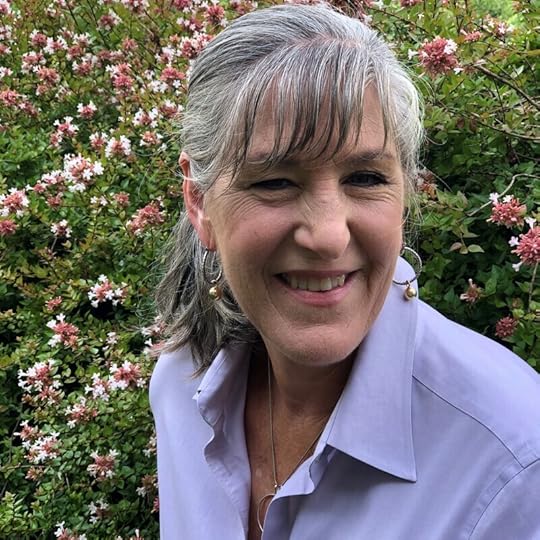 Author Patty Bear Most people who saw my achievements or the uniforms I wore assumed I felt as confident as I apparently looked. Internally though, each new stage brought uncertainty and sometimes paralyzing fear and self-doubt. I used to think this was unique to me. Now I know it’s just a stage in the journey of growth.
Author Patty Bear Most people who saw my achievements or the uniforms I wore assumed I felt as confident as I apparently looked. Internally though, each new stage brought uncertainty and sometimes paralyzing fear and self-doubt. I used to think this was unique to me. Now I know it’s just a stage in the journey of growth.
Change doesn’t require courage because change happens outside of us, with or without our agreement. But transformation is different. Transformation only takes place with our permission.
No matter how old we are or how many times we have reinvented ourselves, it’s still a pioneering walk into the unknown. Like the caterpillar, we literally must shed an old self to access higher planes of freedom and more expansive, colorful lives.
It takes courage to make the terrifying passage through the liminal space between who we were and who we have not yet become, but it’s worth it.
Life’s an adventure. Live it! Thank you for sharing your story today, Patty!
After graduating from the USAF Academy, in the seventh class of women admitted, Patty became a KC-135 pilot deployed to the Middle East during Desert Storm. Later, she deployed to Riyadh, Saudi Arabia, on a peace keeping mission refueling air force planes over postwar Iraq.
You can read Patty's full story in her award-winning memoir From Plain to Plane: My Mennonite Childhood, A National Scandal, and an Unconventional Soar to Freedom 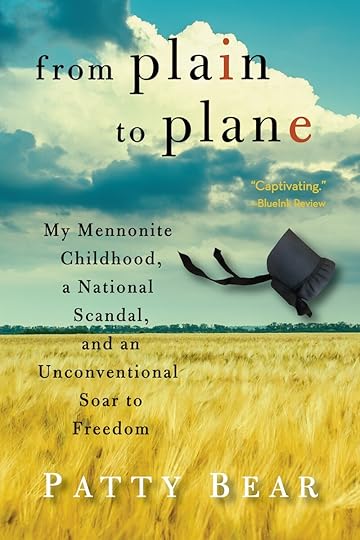
Sources and further reading
https://nypost.com/2021/02/22/how-i-escaped-the-mennonites-and-my-domestic-terrorist-father/amp/
https://www.nytimes.com/1973/07/23/archives/mennonite-dissident-shunned-by-church-and-wife-mennonite-dissident.html
https://coffeeordie.com/patty-bear-mennonite-to-military/
This week, one woman's story moves a step beyond, showing how courage can lead to transformation.
Patty Bear grew up in the Mennonite faith which holds pacificism as a foundational belief, but the cruel truth? Violence ruled her home and family.
In retrospect, she called her father a "domestic terrorist" who abused her mother for years. But when he questioned Mennonite leaders and was excommunicated, the media portrayed him as the victim , a man shunned by his wife and children.
Patty went from her sheltered, rural life where her father regarded her mother as property, like another animal on his farm, to becoming a pioneering woman pilot in the United States Air Force.
 (Left) Patty in second grade. (At right) Patty in pilot training alongside the supersonic T-38. That's transformation!
(Left) Patty in second grade. (At right) Patty in pilot training alongside the supersonic T-38. That's transformation! Patty agreed to tell her story for us this week.
Patricia Bear: Soaring to Freedom
Transformation is a lovely concept, but someone should warn us it won’t just change our circumstances, it will change who we are. And that will be a terrifying journey into the unknown. The high school loudspeaker blared an announcement that a cadet from the US Air Force Academy would make a presentation. I did not know what this place was. My best guess was, maybe it had something to do with flying?
Out of dire necessity, we had migrated from our small, rural school to this much larger school, where I still felt wildly out of place in this “worldly” world where people took for granted things I had never heard of and where I was acutely aware of my family’s differentness.
Growing up among the insular Plain People in an Old Order Mennonite community where voting, “going to the law”, and serving in the military were strictly forbidden. Where “worldly” jobs like pilot or real estate agent were prohibited for men who might get corrupted by exposure to the temptations of the outside world. Where women’s highest allowed ambition was to mother a large brood of children or perhaps run a business with their husband.
 Patty's mother (center back) heading into one of the several court cases. Excommunication and shunning had suddenly and dramatically upended our isolated but mostly bucolic farm life. It had ignited a decade of living on the run from violence while dodging local and national reporters and the searing publicity that accompanied our story and its court cases, one of which went to the PA Supreme Court.
Patty's mother (center back) heading into one of the several court cases. Excommunication and shunning had suddenly and dramatically upended our isolated but mostly bucolic farm life. It had ignited a decade of living on the run from violence while dodging local and national reporters and the searing publicity that accompanied our story and its court cases, one of which went to the PA Supreme Court.Years passed, I felt trapped in a nightmare with no ending. But I was trying to wake up. Trying to escape the gravity I had been born into.
On the morning of the mysterious announcement, uncharacteristically having nothing to do in the next period study hall, I shrugged my shoulders and thought, “why not check this out?” Forty-five minutes later, I emerged dazed, but utterly sure that this wildly unforeseen possibility was my answer.
Flying would become my ticket to liberation, and the military, as it has been for so many, would be my transportation to the entire world.
Though I had been taking concrete steps forward, I wouldn’t realize until years later the importance of dreaming, planning, and thinking. These subtle, internal efforts were slowly chipping away at my old self. Chipping away at the heavy indoctrinations I carried. And when I became just barely light enough, a door opened, and I flew out into a new world.
 Patty Bear in her US Air Force Academy graduation photo. In some ways, this new world was all too familiar: overtly male centered, heavy indoctrination, highly regimented, and rigid.
Patty Bear in her US Air Force Academy graduation photo. In some ways, this new world was all too familiar: overtly male centered, heavy indoctrination, highly regimented, and rigid. After years of the publicity frenzy surrounding our family along with my mother’s distinctive Plain clothes and black bonnet relentlessly exposing our presence, I craved the anonymity of being sixteen hundred miles away. I had not digested the reality that girls, being only ten percent of the school, meant automatically sticking out in the same unwanted way as it had before.
But in so many other ways, it was vastly different. Nothing was familiar. Not military life, not the food, not even the climate. My mother sent me dried pressed leaves because I missed deciduous trees so much.
 Patty's mom sees her off at the airport as she leaves home to report, for the first time, to the USAF Academy in Colorado Springs, CO. Encountering foreign concepts like networking that seemed normal to others left me bewildered. Why would someone make friends to get something? And I felt profoundly lonely so far from my family, given only one five-minute phone call per week. They ordered me to eat mounds of ice cream because I lost so much weight. I got severely sick. I wanted to quit.
Patty's mom sees her off at the airport as she leaves home to report, for the first time, to the USAF Academy in Colorado Springs, CO. Encountering foreign concepts like networking that seemed normal to others left me bewildered. Why would someone make friends to get something? And I felt profoundly lonely so far from my family, given only one five-minute phone call per week. They ordered me to eat mounds of ice cream because I lost so much weight. I got severely sick. I wanted to quit.Much later, I would come to understand two things. Doors open when we become light enough to fly through the opening. And a door opening is not the end of our transformation, it’s the beginning. It signals that we are just barely capable of surviving in a new world.
My friends, transformation is not for the timid. And it’s not for those more committed to confidence than growth.
Eventually, my experience at the Academy would make me different. It would chip away at old beliefs while creating new thought patterns and new habits. And those developments would pave the way for me to fly through more open doors and to be just barely ready to become an Air Force pilot, then an aircraft commander, an international airline captain, and an author.
 Author Patty Bear Most people who saw my achievements or the uniforms I wore assumed I felt as confident as I apparently looked. Internally though, each new stage brought uncertainty and sometimes paralyzing fear and self-doubt. I used to think this was unique to me. Now I know it’s just a stage in the journey of growth.
Author Patty Bear Most people who saw my achievements or the uniforms I wore assumed I felt as confident as I apparently looked. Internally though, each new stage brought uncertainty and sometimes paralyzing fear and self-doubt. I used to think this was unique to me. Now I know it’s just a stage in the journey of growth.Change doesn’t require courage because change happens outside of us, with or without our agreement. But transformation is different. Transformation only takes place with our permission.
No matter how old we are or how many times we have reinvented ourselves, it’s still a pioneering walk into the unknown. Like the caterpillar, we literally must shed an old self to access higher planes of freedom and more expansive, colorful lives.
It takes courage to make the terrifying passage through the liminal space between who we were and who we have not yet become, but it’s worth it.
Life’s an adventure. Live it! Thank you for sharing your story today, Patty!
After graduating from the USAF Academy, in the seventh class of women admitted, Patty became a KC-135 pilot deployed to the Middle East during Desert Storm. Later, she deployed to Riyadh, Saudi Arabia, on a peace keeping mission refueling air force planes over postwar Iraq.
You can read Patty's full story in her award-winning memoir From Plain to Plane: My Mennonite Childhood, A National Scandal, and an Unconventional Soar to Freedom

Sources and further reading
https://nypost.com/2021/02/22/how-i-escaped-the-mennonites-and-my-domestic-terrorist-father/amp/
https://www.nytimes.com/1973/07/23/archives/mennonite-dissident-shunned-by-church-and-wife-mennonite-dissident.html
https://coffeeordie.com/patty-bear-mennonite-to-military/
Published on February 27, 2023 13:55
Tour of Transformation: From Mennonite Farm to the Skys of War
Courage wears many different faces, as shown in the varied stories I've sent you, as well as in my books.
This week, one woman's story moves a step beyond, showing how courage can lead to transformation.
Patricia Bear grew up in the Mennonite faith which holds pacificism as a foundational belief, but the cruel truth? Violence ruled her home and family.
In retrospect, she called her father a "domestic terrorist" who abused her mother for years. But when he questioned Mennonite leaders and was excommunicated, the media portrayed him as the victim , a man shunned by his wife and children.
Patricia went from her sheltered, rural life where her father regarded her mother as property, like another animal on his farm, to becoming a pioneering woman pilot in the United States Air Force. (Left) Patricia in second grade. (At right) Patricia in pilot training alongside the supersonic T-38. That's transformation!
(Left) Patricia in second grade. (At right) Patricia in pilot training alongside the supersonic T-38. That's transformation!
Patricia agreed to tell her story for us this week.
Patricia Bear: Soaring to Freedom
Transformation is a lovely concept, but someone should warn us it won’t just change our circumstances, it will change who we are. And that will be a terrifying journey into the unknown. The high school loudspeaker blared an announcement that a cadet from the US Air Force Academy would make a presentation. I did not know what this place was. My best guess was, maybe it had something to do with flying?
Out of dire necessity, we had migrated from our small, rural school to this much larger school, where I still felt wildly out of place in this “worldly” world where people took for granted things I had never heard of and where I was acutely aware of my family’s differentness.
Growing up among the insular Plain People in an Old Order Mennonite community where voting, “going to the law”, and serving in the military were strictly forbidden. Where “worldly” jobs like pilot or real estate agent were prohibited for men who might get corrupted by exposure to the temptations of the outside world. Where women’s highest allowed ambition was to mother a large brood of children or perhaps run a business with their husband. Patricia's mother (center back) heading into one of the several court cases. Excommunication and shunning had suddenly and dramatically upended our isolated but mostly bucolic farm life. It had ignited a decade of living on the run from violence while dodging local and national reporters and the searing publicity that accompanied our story and its court cases, one of which went to the PA Supreme Court.
Patricia's mother (center back) heading into one of the several court cases. Excommunication and shunning had suddenly and dramatically upended our isolated but mostly bucolic farm life. It had ignited a decade of living on the run from violence while dodging local and national reporters and the searing publicity that accompanied our story and its court cases, one of which went to the PA Supreme Court.
Years passed, I felt trapped in a nightmare with no ending. But I was trying to wake up. Trying to escape the gravity I had been born into.
On the morning of the mysterious announcement, uncharacteristically having nothing to do in the next period study hall, I shrugged my shoulders and thought, “why not check this out?” Forty-five minutes later, I emerged dazed, but utterly sure that this wildly unforeseen possibility was my answer.
Flying would become my ticket to liberation, and the military, as it has been for so many, would be my transportation to the entire world.
Though I had been taking concrete steps forward, I wouldn’t realize until years later the importance of dreaming, planning, and thinking. These subtle, internal efforts were slowly chipping away at my old self. Chipping away at the heavy indoctrinations I carried. And when I became just barely light enough, a door opened, and I flew out into a new world.  Patricia Bear in her US Air Force Academy graduation photo. In some ways, this new world was all too familiar: overtly male centered, heavy indoctrination, highly regimented, and rigid.
Patricia Bear in her US Air Force Academy graduation photo. In some ways, this new world was all too familiar: overtly male centered, heavy indoctrination, highly regimented, and rigid.
After years of the publicity frenzy surrounding our family along with my mother’s distinctive Plain clothes and black bonnet relentlessly exposing our presence, I craved the anonymity of being sixteen hundred miles away. I had not digested the reality that girls, being only ten percent of the school, meant automatically sticking out in the same unwanted way as it had before.
But in so many other ways, it was vastly different. Nothing was familiar. Not military life, not the food, not even the climate. My mother sent me dried pressed leaves because I missed deciduous trees so much.  Patricia's mom sees her off at the airport as she leaves home to report, for the first time, to the USAF Academy in Colorado Springs, CO. Encountering foreign concepts like networking that seemed normal to others left me bewildered. Why would someone make friends to get something? And I felt profoundly lonely so far from my family, given only one five-minute phone call per week. They ordered me to eat mounds of ice cream because I lost so much weight. I got severely sick. I wanted to quit.
Patricia's mom sees her off at the airport as she leaves home to report, for the first time, to the USAF Academy in Colorado Springs, CO. Encountering foreign concepts like networking that seemed normal to others left me bewildered. Why would someone make friends to get something? And I felt profoundly lonely so far from my family, given only one five-minute phone call per week. They ordered me to eat mounds of ice cream because I lost so much weight. I got severely sick. I wanted to quit.
Much later, I would come to understand two things. Doors open when we become light enough to fly through the opening. And a door opening is not the end of our transformation, it’s the beginning. It signals that we are just barely capable of surviving in a new world.
My friends, transformation is not for the timid. And it’s not for those more committed to confidence than growth.
Eventually, my experience at the Academy would make me different. It would chip away at old beliefs while creating new thought patterns and new habits. And those developments would pave the way for me to fly through more open doors and to be just barely ready to become an Air Force pilot, then an aircraft commander, an international airline captain, and an author. Author Patricia Bear Most people who saw my achievements or the uniforms I wore assumed I felt as confident as I apparently looked. Internally though, each new stage brought uncertainty and sometimes paralyzing fear and self-doubt. I used to think this was unique to me. Now I know it’s just a stage in the journey of growth.
Author Patricia Bear Most people who saw my achievements or the uniforms I wore assumed I felt as confident as I apparently looked. Internally though, each new stage brought uncertainty and sometimes paralyzing fear and self-doubt. I used to think this was unique to me. Now I know it’s just a stage in the journey of growth.
Change doesn’t require courage because change happens outside of us, with or without our agreement. But transformation is different. Transformation only takes place with our permission.
No matter how old we are or how many times we have reinvented ourselves, it’s still a pioneering walk into the unknown. Like the caterpillar, we literally must shed an old self to access higher planes of freedom and more expansive, colorful lives.
It takes courage to make the terrifying passage through the liminal space between who we were and who we have not yet become, but it’s worth it.
Life’s an adventure. Live it! Thank you for sharing your story today, Patricia!
After graduating from the USAF Academy, in the seventh class of women admitted, Patricia became a KC-135 pilot deployed to the Middle East during Desert Storm. Later, she deployed to Riyadh, Saudi Arabia, on a peace keeping mission refueling air force planes over postwar Iraq.
You can read Patricia's full story in her award-winning memoir From Plain to Plane: My Mennonite Childhood, A National Scandal, and an Unconventional Soar to Freedom 
Sources and further reading
https://nypost.com/2021/02/22/how-i-escaped-the-mennonites-and-my-domestic-terrorist-father/amp/
https://www.nytimes.com/1973/07/23/archives/mennonite-dissident-shunned-by-church-and-wife-mennonite-dissident.html
https://coffeeordie.com/patty-bear-mennonite-to-military/
This week, one woman's story moves a step beyond, showing how courage can lead to transformation.
Patricia Bear grew up in the Mennonite faith which holds pacificism as a foundational belief, but the cruel truth? Violence ruled her home and family.
In retrospect, she called her father a "domestic terrorist" who abused her mother for years. But when he questioned Mennonite leaders and was excommunicated, the media portrayed him as the victim , a man shunned by his wife and children.
Patricia went from her sheltered, rural life where her father regarded her mother as property, like another animal on his farm, to becoming a pioneering woman pilot in the United States Air Force.
 (Left) Patricia in second grade. (At right) Patricia in pilot training alongside the supersonic T-38. That's transformation!
(Left) Patricia in second grade. (At right) Patricia in pilot training alongside the supersonic T-38. That's transformation! Patricia agreed to tell her story for us this week.
Patricia Bear: Soaring to Freedom
Transformation is a lovely concept, but someone should warn us it won’t just change our circumstances, it will change who we are. And that will be a terrifying journey into the unknown. The high school loudspeaker blared an announcement that a cadet from the US Air Force Academy would make a presentation. I did not know what this place was. My best guess was, maybe it had something to do with flying?
Out of dire necessity, we had migrated from our small, rural school to this much larger school, where I still felt wildly out of place in this “worldly” world where people took for granted things I had never heard of and where I was acutely aware of my family’s differentness.
Growing up among the insular Plain People in an Old Order Mennonite community where voting, “going to the law”, and serving in the military were strictly forbidden. Where “worldly” jobs like pilot or real estate agent were prohibited for men who might get corrupted by exposure to the temptations of the outside world. Where women’s highest allowed ambition was to mother a large brood of children or perhaps run a business with their husband.
 Patricia's mother (center back) heading into one of the several court cases. Excommunication and shunning had suddenly and dramatically upended our isolated but mostly bucolic farm life. It had ignited a decade of living on the run from violence while dodging local and national reporters and the searing publicity that accompanied our story and its court cases, one of which went to the PA Supreme Court.
Patricia's mother (center back) heading into one of the several court cases. Excommunication and shunning had suddenly and dramatically upended our isolated but mostly bucolic farm life. It had ignited a decade of living on the run from violence while dodging local and national reporters and the searing publicity that accompanied our story and its court cases, one of which went to the PA Supreme Court.Years passed, I felt trapped in a nightmare with no ending. But I was trying to wake up. Trying to escape the gravity I had been born into.
On the morning of the mysterious announcement, uncharacteristically having nothing to do in the next period study hall, I shrugged my shoulders and thought, “why not check this out?” Forty-five minutes later, I emerged dazed, but utterly sure that this wildly unforeseen possibility was my answer.
Flying would become my ticket to liberation, and the military, as it has been for so many, would be my transportation to the entire world.
Though I had been taking concrete steps forward, I wouldn’t realize until years later the importance of dreaming, planning, and thinking. These subtle, internal efforts were slowly chipping away at my old self. Chipping away at the heavy indoctrinations I carried. And when I became just barely light enough, a door opened, and I flew out into a new world.
 Patricia Bear in her US Air Force Academy graduation photo. In some ways, this new world was all too familiar: overtly male centered, heavy indoctrination, highly regimented, and rigid.
Patricia Bear in her US Air Force Academy graduation photo. In some ways, this new world was all too familiar: overtly male centered, heavy indoctrination, highly regimented, and rigid. After years of the publicity frenzy surrounding our family along with my mother’s distinctive Plain clothes and black bonnet relentlessly exposing our presence, I craved the anonymity of being sixteen hundred miles away. I had not digested the reality that girls, being only ten percent of the school, meant automatically sticking out in the same unwanted way as it had before.
But in so many other ways, it was vastly different. Nothing was familiar. Not military life, not the food, not even the climate. My mother sent me dried pressed leaves because I missed deciduous trees so much.
 Patricia's mom sees her off at the airport as she leaves home to report, for the first time, to the USAF Academy in Colorado Springs, CO. Encountering foreign concepts like networking that seemed normal to others left me bewildered. Why would someone make friends to get something? And I felt profoundly lonely so far from my family, given only one five-minute phone call per week. They ordered me to eat mounds of ice cream because I lost so much weight. I got severely sick. I wanted to quit.
Patricia's mom sees her off at the airport as she leaves home to report, for the first time, to the USAF Academy in Colorado Springs, CO. Encountering foreign concepts like networking that seemed normal to others left me bewildered. Why would someone make friends to get something? And I felt profoundly lonely so far from my family, given only one five-minute phone call per week. They ordered me to eat mounds of ice cream because I lost so much weight. I got severely sick. I wanted to quit.Much later, I would come to understand two things. Doors open when we become light enough to fly through the opening. And a door opening is not the end of our transformation, it’s the beginning. It signals that we are just barely capable of surviving in a new world.
My friends, transformation is not for the timid. And it’s not for those more committed to confidence than growth.
Eventually, my experience at the Academy would make me different. It would chip away at old beliefs while creating new thought patterns and new habits. And those developments would pave the way for me to fly through more open doors and to be just barely ready to become an Air Force pilot, then an aircraft commander, an international airline captain, and an author.
 Author Patricia Bear Most people who saw my achievements or the uniforms I wore assumed I felt as confident as I apparently looked. Internally though, each new stage brought uncertainty and sometimes paralyzing fear and self-doubt. I used to think this was unique to me. Now I know it’s just a stage in the journey of growth.
Author Patricia Bear Most people who saw my achievements or the uniforms I wore assumed I felt as confident as I apparently looked. Internally though, each new stage brought uncertainty and sometimes paralyzing fear and self-doubt. I used to think this was unique to me. Now I know it’s just a stage in the journey of growth.Change doesn’t require courage because change happens outside of us, with or without our agreement. But transformation is different. Transformation only takes place with our permission.
No matter how old we are or how many times we have reinvented ourselves, it’s still a pioneering walk into the unknown. Like the caterpillar, we literally must shed an old self to access higher planes of freedom and more expansive, colorful lives.
It takes courage to make the terrifying passage through the liminal space between who we were and who we have not yet become, but it’s worth it.
Life’s an adventure. Live it! Thank you for sharing your story today, Patricia!
After graduating from the USAF Academy, in the seventh class of women admitted, Patricia became a KC-135 pilot deployed to the Middle East during Desert Storm. Later, she deployed to Riyadh, Saudi Arabia, on a peace keeping mission refueling air force planes over postwar Iraq.
You can read Patricia's full story in her award-winning memoir From Plain to Plane: My Mennonite Childhood, A National Scandal, and an Unconventional Soar to Freedom

Sources and further reading
https://nypost.com/2021/02/22/how-i-escaped-the-mennonites-and-my-domestic-terrorist-father/amp/
https://www.nytimes.com/1973/07/23/archives/mennonite-dissident-shunned-by-church-and-wife-mennonite-dissident.html
https://coffeeordie.com/patty-bear-mennonite-to-military/
Published on February 27, 2023 13:55
January 30, 2023
From Google Doodle to a Spanish Civil war battlefield
There's a new book out featuring one of my favorite historical women, Gerda Taro.
I've written about her before
, telling you about her incredible courage and how she believed photographs could change the world.
In the mid-1930s, Gerda Taro served as a midwife of sorts, helping birth the powerful force of modern photojournalism. The new book is historical fiction based on Gerda's life. One Last Shot is a novel written in verse by Author Kip Wilson. I was immediately drawn to Kip because she has also written a book based on the life of
Sophie Scholl, another young woman I've written you about
and admired since I was 12 years old.
I was immediately drawn to Kip because she has also written a book based on the life of
Sophie Scholl, another young woman I've written you about
and admired since I was 12 years old.
So it is with great pleasure that I welcome Author Kip Wilson to tell you about her new book and her journey writing it. (All the way to the fields of the Spanish Civil War) Take it away, Kip...
I first learned about Gerda Taro from the Google Doodle on her birthday on August 1, 2018. Although I’ve been an amateur photographer and photography fan since high school, I’d never heard of this impish-looking girl holding the camera in the Doodle. I clicked it right away. Google Doodle from 8/1/2018 As soon as I learned that Gerda Taro was a foreign photojournalist who covered the Spanish Civil War, I was more than hooked. I’m married to a Spaniard and have been slowly learning about this turbulent time in history since I first visited the country over twenty years ago, but as a writer of YA historical fiction, I hadn’t yet found quite the right angle to investigate.
Google Doodle from 8/1/2018 As soon as I learned that Gerda Taro was a foreign photojournalist who covered the Spanish Civil War, I was more than hooked. I’m married to a Spaniard and have been slowly learning about this turbulent time in history since I first visited the country over twenty years ago, but as a writer of YA historical fiction, I hadn’t yet found quite the right angle to investigate.
The more I learned about Gerda, the more I loved her: her profoundly anti-fascist views, her multilingual and photography skills, her charm, her unrivaled confidence, and her perfectly balanced combination of femininity and toughness. The details I learned brought her to life for me as a YA heroine. Definitely someone I wanted to spend time with!
My family and I travel to Spain every couple of years, so I went ahead and booked flights and an apartment for the summer of 2020 to combine visits to relatives with some on-the-ground research. Then COVID hit. Obviously, I had to cancel those plans, and my in-person research became armchair research.  Author Kip Wilson, Photo Credit © Rosanne Samson At this point, I continued by focusing on available electronic resources, including newspapers from the era I was able to access in German, Spanish, and French, as well as additional videos and documents I could find online. I also contacted several authors who’d written about Gerda Taro with some specific questions, which they kindly answered for me, helping me form a clearer picture of some of the key moments and relationships in her life. It was starting to come together!
Author Kip Wilson, Photo Credit © Rosanne Samson At this point, I continued by focusing on available electronic resources, including newspapers from the era I was able to access in German, Spanish, and French, as well as additional videos and documents I could find online. I also contacted several authors who’d written about Gerda Taro with some specific questions, which they kindly answered for me, helping me form a clearer picture of some of the key moments and relationships in her life. It was starting to come together!
But there’s still something amazing about getting to experience an important historical place in person, and luckily I did finally manage to visit Spain again in 2022. I’d made contact with several Spanish Civil War experts in the area, and we made plans to visit some key sites together during my stay.
In Madrid, historian Almudena Cros and I spent a morning visiting everywhere from the University City where fierce fighting took place in 1936 to the palace that housed the Alianza de Escritores Antifascistas—Gerda Taro’s home base in the city.
 Former home of the Alianza, photo courtesy Kip Wilson West of Madrid, Alan Warren—an expert on the International Brigades—brought me to the museum of La Mujer en la Guerra Civil in Navalgamella, where they have an amazing life-size portrait of Gerda Taro, along with plenty of other works of art, uniforms, etc.
Former home of the Alianza, photo courtesy Kip Wilson West of Madrid, Alan Warren—an expert on the International Brigades—brought me to the museum of La Mujer en la Guerra Civil in Navalgamella, where they have an amazing life-size portrait of Gerda Taro, along with plenty of other works of art, uniforms, etc.  La mujer en la guerra civil, photo courtesy Alan Warren. We also got together with some other local historians and visited the roadside site where Gerda was run over by a tank during the Battle of Brunete.
La mujer en la guerra civil, photo courtesy Alan Warren. We also got together with some other local historians and visited the roadside site where Gerda was run over by a tank during the Battle of Brunete.
In the midst of a heat wave a few weeks later—on the 85th anniversary of Gerda Taro’s death—we went back to the same spot and planted some lavender in Gerda’s honor beside the tree that marks the site. It was an incredibly moving day. Alan read from Robert Capa’s Death in the Making, the book Robert put together in Gerda’s honor, and I read from One Last Shot. Kip Wilson at the Brunette battlefield, photo courtesy Alicia García López. Out there baking under the heat of the Spanish sun, I couldn’t help thinking of the teen readers who’d soon be holding a copy of my book and learning about Gerda Taro and the impact she made with her photographs, her passion, and her determination to make a difference.
Kip Wilson at the Brunette battlefield, photo courtesy Alicia García López. Out there baking under the heat of the Spanish sun, I couldn’t help thinking of the teen readers who’d soon be holding a copy of my book and learning about Gerda Taro and the impact she made with her photographs, her passion, and her determination to make a difference.
For my early research, I began reading all the books about her I could get my hands on. I began with Eyes of the World: Robert Capa, Gerda Taro, and the Invention of Modern Photojournalism by Marc Aronson and Marina Budhos, a fabulous nonfiction book for young adults. I also read two incredible biographies, Gerta Taro: Fotoreporterin im spanischen Bürgerkrieg (in German) by Irme Schaber, and Gerda Taro: Inventing Robert Capa by Jane Rogoyska. Both of these filled in a lot of blanks for me.
I, of course, also studied the incredible photographs Gerda Taro herself shot, many of which are available at the International Center of Photography , as well as photographs of Gerda, which likewise reveal a lot about her character. Gerda Taro at work. But it was definitely challenging researching someone less well known than the subject of my first book,
White Rose,
about World War II German resistance member Sophie Scholl. In Sophie’s case, there are plenty of primary source documents as well as books and interviews available, including quite a few that had been translated in English. Not so with Gerda, whose work had been largely forgotten until the discovery of the so-called “Mexican Suitcase” in 2007.
Gerda Taro at work. But it was definitely challenging researching someone less well known than the subject of my first book,
White Rose,
about World War II German resistance member Sophie Scholl. In Sophie’s case, there are plenty of primary source documents as well as books and interviews available, including quite a few that had been translated in English. Not so with Gerda, whose work had been largely forgotten until the discovery of the so-called “Mexican Suitcase” in 2007.
The Mexican Suitcase is an excellent documentary film from 2011 directed by Trisha Ziff that explains how the rolls of over 400 negatives in the three boxes that became collectively known as the “Mexican Suitcase” made their way from Spain to Mexico and eventually to the International Center of Photography in New York, founded by Robert Capa’s brother Cornell. Most interesting of all to me was how experts were able to identify and attribute work of each of the three photographers in the “suitcase” (Gerda, Robert, and their friend David Seymour, known as Chim).
By the time I’d seen the film, I’d already read all the books I could track down, including not only ones about Gerda, but also several about Robert Capa. I had enough information to complete my first draft of the manuscript, so I was ready to get up close with some of the key historical sites—to really follow Gerda’s footsteps. I’m personally drawn to the history and the subjects I study, but in the end, the reason I write what I do is for today’s readers. I choose subjects and time periods that I think young people today will find relevant—which hopefully means that they not only learn about this important history, but also that they can take something from it to apply to their own lives. I hope readers will see that Gerda Taro was not only a bright spark back in her own day, but also an inspiration for generations to come.
I’m personally drawn to the history and the subjects I study, but in the end, the reason I write what I do is for today’s readers. I choose subjects and time periods that I think young people today will find relevant—which hopefully means that they not only learn about this important history, but also that they can take something from it to apply to their own lives. I hope readers will see that Gerda Taro was not only a bright spark back in her own day, but also an inspiration for generations to come.
Thanks for you post, Kip! Congratulations on your new book!
In the mid-1930s, Gerda Taro served as a midwife of sorts, helping birth the powerful force of modern photojournalism. The new book is historical fiction based on Gerda's life. One Last Shot is a novel written in verse by Author Kip Wilson.
 I was immediately drawn to Kip because she has also written a book based on the life of
Sophie Scholl, another young woman I've written you about
and admired since I was 12 years old.
I was immediately drawn to Kip because she has also written a book based on the life of
Sophie Scholl, another young woman I've written you about
and admired since I was 12 years old.
So it is with great pleasure that I welcome Author Kip Wilson to tell you about her new book and her journey writing it. (All the way to the fields of the Spanish Civil War) Take it away, Kip...
I first learned about Gerda Taro from the Google Doodle on her birthday on August 1, 2018. Although I’ve been an amateur photographer and photography fan since high school, I’d never heard of this impish-looking girl holding the camera in the Doodle. I clicked it right away.
 Google Doodle from 8/1/2018 As soon as I learned that Gerda Taro was a foreign photojournalist who covered the Spanish Civil War, I was more than hooked. I’m married to a Spaniard and have been slowly learning about this turbulent time in history since I first visited the country over twenty years ago, but as a writer of YA historical fiction, I hadn’t yet found quite the right angle to investigate.
Google Doodle from 8/1/2018 As soon as I learned that Gerda Taro was a foreign photojournalist who covered the Spanish Civil War, I was more than hooked. I’m married to a Spaniard and have been slowly learning about this turbulent time in history since I first visited the country over twenty years ago, but as a writer of YA historical fiction, I hadn’t yet found quite the right angle to investigate.The more I learned about Gerda, the more I loved her: her profoundly anti-fascist views, her multilingual and photography skills, her charm, her unrivaled confidence, and her perfectly balanced combination of femininity and toughness. The details I learned brought her to life for me as a YA heroine. Definitely someone I wanted to spend time with!
My family and I travel to Spain every couple of years, so I went ahead and booked flights and an apartment for the summer of 2020 to combine visits to relatives with some on-the-ground research. Then COVID hit. Obviously, I had to cancel those plans, and my in-person research became armchair research.
 Author Kip Wilson, Photo Credit © Rosanne Samson At this point, I continued by focusing on available electronic resources, including newspapers from the era I was able to access in German, Spanish, and French, as well as additional videos and documents I could find online. I also contacted several authors who’d written about Gerda Taro with some specific questions, which they kindly answered for me, helping me form a clearer picture of some of the key moments and relationships in her life. It was starting to come together!
Author Kip Wilson, Photo Credit © Rosanne Samson At this point, I continued by focusing on available electronic resources, including newspapers from the era I was able to access in German, Spanish, and French, as well as additional videos and documents I could find online. I also contacted several authors who’d written about Gerda Taro with some specific questions, which they kindly answered for me, helping me form a clearer picture of some of the key moments and relationships in her life. It was starting to come together!But there’s still something amazing about getting to experience an important historical place in person, and luckily I did finally manage to visit Spain again in 2022. I’d made contact with several Spanish Civil War experts in the area, and we made plans to visit some key sites together during my stay.
In Madrid, historian Almudena Cros and I spent a morning visiting everywhere from the University City where fierce fighting took place in 1936 to the palace that housed the Alianza de Escritores Antifascistas—Gerda Taro’s home base in the city.
 Former home of the Alianza, photo courtesy Kip Wilson West of Madrid, Alan Warren—an expert on the International Brigades—brought me to the museum of La Mujer en la Guerra Civil in Navalgamella, where they have an amazing life-size portrait of Gerda Taro, along with plenty of other works of art, uniforms, etc.
Former home of the Alianza, photo courtesy Kip Wilson West of Madrid, Alan Warren—an expert on the International Brigades—brought me to the museum of La Mujer en la Guerra Civil in Navalgamella, where they have an amazing life-size portrait of Gerda Taro, along with plenty of other works of art, uniforms, etc.  La mujer en la guerra civil, photo courtesy Alan Warren. We also got together with some other local historians and visited the roadside site where Gerda was run over by a tank during the Battle of Brunete.
La mujer en la guerra civil, photo courtesy Alan Warren. We also got together with some other local historians and visited the roadside site where Gerda was run over by a tank during the Battle of Brunete.In the midst of a heat wave a few weeks later—on the 85th anniversary of Gerda Taro’s death—we went back to the same spot and planted some lavender in Gerda’s honor beside the tree that marks the site. It was an incredibly moving day. Alan read from Robert Capa’s Death in the Making, the book Robert put together in Gerda’s honor, and I read from One Last Shot.
 Kip Wilson at the Brunette battlefield, photo courtesy Alicia García López. Out there baking under the heat of the Spanish sun, I couldn’t help thinking of the teen readers who’d soon be holding a copy of my book and learning about Gerda Taro and the impact she made with her photographs, her passion, and her determination to make a difference.
Kip Wilson at the Brunette battlefield, photo courtesy Alicia García López. Out there baking under the heat of the Spanish sun, I couldn’t help thinking of the teen readers who’d soon be holding a copy of my book and learning about Gerda Taro and the impact she made with her photographs, her passion, and her determination to make a difference.For my early research, I began reading all the books about her I could get my hands on. I began with Eyes of the World: Robert Capa, Gerda Taro, and the Invention of Modern Photojournalism by Marc Aronson and Marina Budhos, a fabulous nonfiction book for young adults. I also read two incredible biographies, Gerta Taro: Fotoreporterin im spanischen Bürgerkrieg (in German) by Irme Schaber, and Gerda Taro: Inventing Robert Capa by Jane Rogoyska. Both of these filled in a lot of blanks for me.
I, of course, also studied the incredible photographs Gerda Taro herself shot, many of which are available at the International Center of Photography , as well as photographs of Gerda, which likewise reveal a lot about her character.
 Gerda Taro at work. But it was definitely challenging researching someone less well known than the subject of my first book,
White Rose,
about World War II German resistance member Sophie Scholl. In Sophie’s case, there are plenty of primary source documents as well as books and interviews available, including quite a few that had been translated in English. Not so with Gerda, whose work had been largely forgotten until the discovery of the so-called “Mexican Suitcase” in 2007.
Gerda Taro at work. But it was definitely challenging researching someone less well known than the subject of my first book,
White Rose,
about World War II German resistance member Sophie Scholl. In Sophie’s case, there are plenty of primary source documents as well as books and interviews available, including quite a few that had been translated in English. Not so with Gerda, whose work had been largely forgotten until the discovery of the so-called “Mexican Suitcase” in 2007.The Mexican Suitcase is an excellent documentary film from 2011 directed by Trisha Ziff that explains how the rolls of over 400 negatives in the three boxes that became collectively known as the “Mexican Suitcase” made their way from Spain to Mexico and eventually to the International Center of Photography in New York, founded by Robert Capa’s brother Cornell. Most interesting of all to me was how experts were able to identify and attribute work of each of the three photographers in the “suitcase” (Gerda, Robert, and their friend David Seymour, known as Chim).
By the time I’d seen the film, I’d already read all the books I could track down, including not only ones about Gerda, but also several about Robert Capa. I had enough information to complete my first draft of the manuscript, so I was ready to get up close with some of the key historical sites—to really follow Gerda’s footsteps.
 I’m personally drawn to the history and the subjects I study, but in the end, the reason I write what I do is for today’s readers. I choose subjects and time periods that I think young people today will find relevant—which hopefully means that they not only learn about this important history, but also that they can take something from it to apply to their own lives. I hope readers will see that Gerda Taro was not only a bright spark back in her own day, but also an inspiration for generations to come.
I’m personally drawn to the history and the subjects I study, but in the end, the reason I write what I do is for today’s readers. I choose subjects and time periods that I think young people today will find relevant—which hopefully means that they not only learn about this important history, but also that they can take something from it to apply to their own lives. I hope readers will see that Gerda Taro was not only a bright spark back in her own day, but also an inspiration for generations to come.
Thanks for you post, Kip! Congratulations on your new book!
Published on January 30, 2023 15:11



